- Go School Trip - Make Better Tomorrow

- Search for:
- Vietnam School Trips
- Cambodia School Trips
- Laos School Trips
- Myanmar School Trips
- Thailand School Trips
- Indonesia School Trips
- Japan School Trips
- Singapore School Trips
- China School Trips

School Trip Blog
What is field trip | definition of field trip in education.
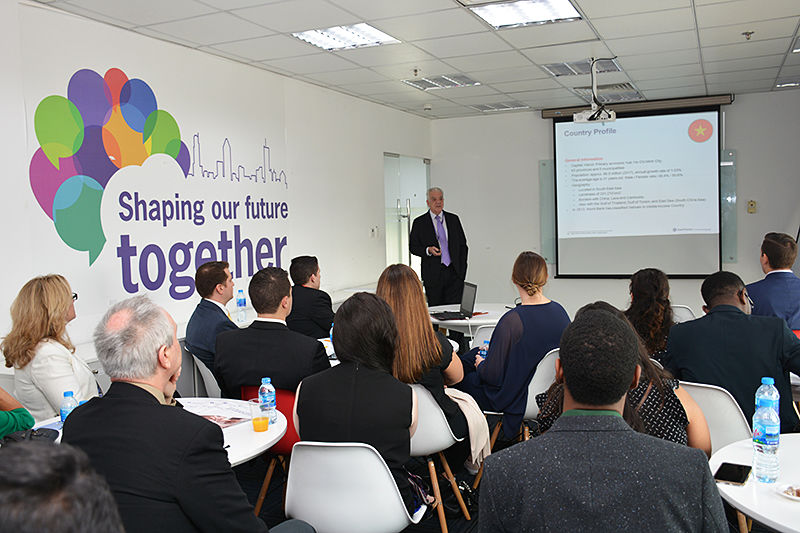
The term “field trip” has been known for decades in many sectors and it is a common term used in worldwide schools. It seems that a field trip is a favorite part of both teachers and students who are keen on learning and discovering. So, what is a field trip in education? Scroll down to find out the field trip definition and its many types.
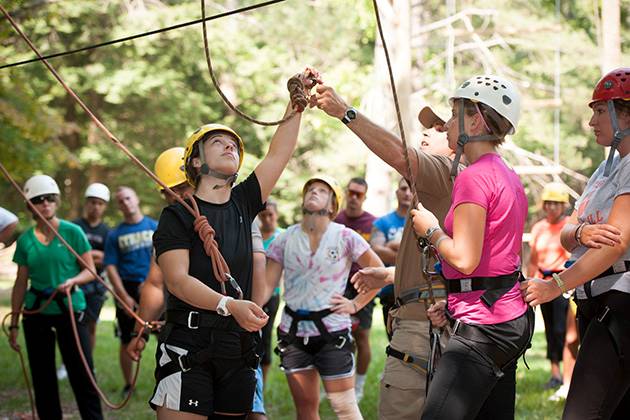
Educational Field Trip Definition
A field trip or excursion is a journey taken by a group of people to a place away from their usual environment. In education, field trips are defined as visits to an outside area of the normal classroom and made by a teacher and students for purposes of firsthand observation. A field trip can be expressed in many terminologies. People call educational trips or school tours in the UK and New Zealand, and school tours in the Philippines. Field trips are a popular method carried out for students to introduce to the concepts, experiences, and ideas that cannot be given in a classroom environment. School tours can be considered as short-term learning activities providing students the opportunity to observe their chosen subject outside of a classroom setting. Exploring other cultures and customs, getting to the motherland of languages, uncovering pristine nature and experiencing fascinating local life are striking demonstrations of educational school trips
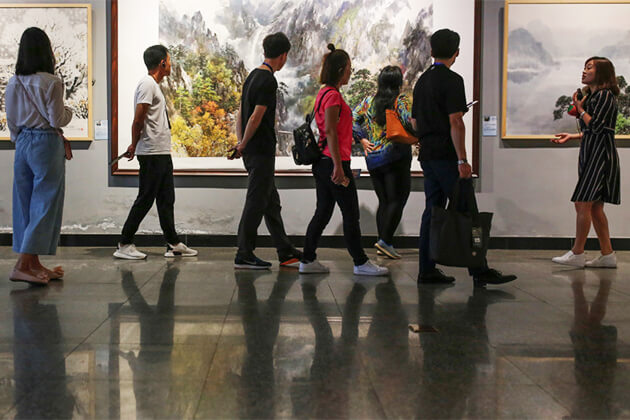
Types of Field Trips
Those listed field trip ideas that help to clear field trip meaning. Efficient educational tours can spark students’ imagination, give them valuable experiences and refresh their minds after days with pencils and papers. A school tour can be themed with one type of field trip or combined by various school trip ideas.
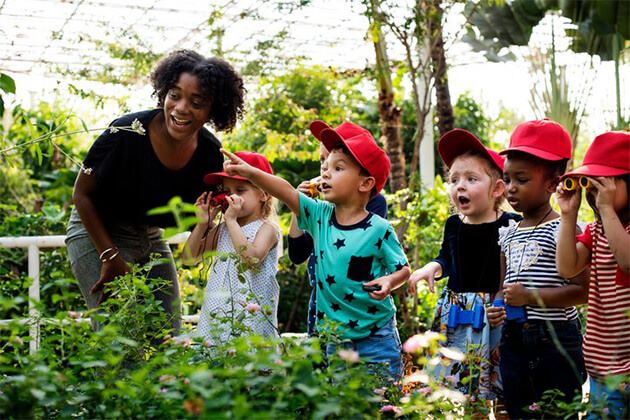
Sightseeing Field Trip
Students are definitely eager the most to sightseeing school trips enchanting them by a myriad of appealing attractions in their wish destination. Admire well-known attractions, explore historic structures, discover World Heritage Sites, unwind on spectacular landscapes and freshen in front of scenic vista are incredible activities that gain huge interests from students and strongly inspire them.
Language and Culture Educational Field Trip
For students learning foreign languages, field trips are very important and helpful to improve the language and explore the alluring indigenous culture. Join immersive activities, stay at a local homestay, take language lessons and visit local markets enable students to practice the language, get a deeper understanding of local culture and their captivating paces of life.
Gardening and Farming Field Trip
This might be an interesting activity attracts lots of students’ attention thanks to its strangeness to their usual life. Discover specialty farms that grow the normal crop and even irregular crops will surprise curious students. Learn how vegetables are produced, explore and give a try to do traditional farming techniques of local people leaves memorable experiences for students.
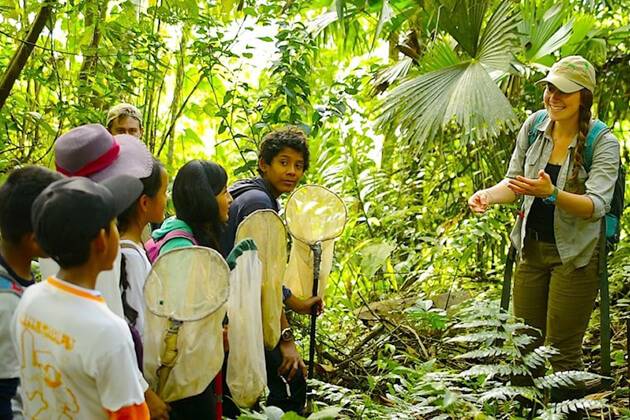
Manufacturing Facility Field Trip
Students can be guided to any factory where equipment, cars, tools, packaging or any other things are made. The mechanized facilities and assembly lines are interesting for students to learn about the production process, how raw materials are utilized and how workers use them to make the final product.
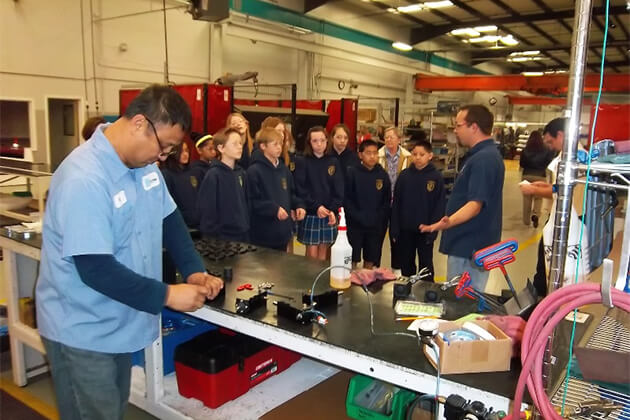
Eco-adventure Field Trip
Discover the natural world is a highly important perspective in the educational sector. Students can be entertained and refreshed by trekking through untouched natural beauties to inspect local plant life and wildlife animals. This opportunity also adds to local historical factors such as early life remnants.
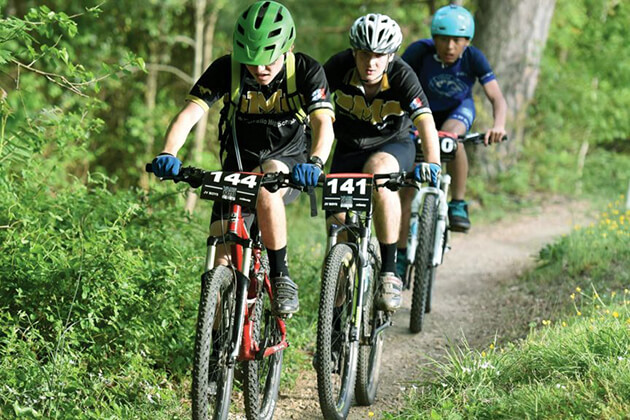
Business Educational Tour
Take business study trips, your students will be delighted by bustling financial and business centers. Business study trips help process business theories in the classroom into life as students explore great commercial organizations. Business field trip gives students the chance to immerse in stimulating and dynamic environments. Visit a range of famed organizations and large corporations will perfect business school trips.

Username or email address *
Password *
Remember me Log in
Lost your password?
- More from M-W
- To save this word, you'll need to log in. Log In
Definition of field trip
Examples of field trip in a sentence.
These examples are programmatically compiled from various online sources to illustrate current usage of the word 'field trip.' Any opinions expressed in the examples do not represent those of Merriam-Webster or its editors. Send us feedback about these examples.
Word History
1926, in the meaning defined above
Dictionary Entries Near field trip
field trial
Cite this Entry
“Field trip.” Merriam-Webster.com Dictionary , Merriam-Webster, https://www.merriam-webster.com/dictionary/field%20trip. Accessed 25 Aug. 2024.
Kids Definition
Kids definition of field trip, more from merriam-webster on field trip.
Thesaurus: All synonyms and antonyms for field trip
Subscribe to America's largest dictionary and get thousands more definitions and advanced search—ad free!

Can you solve 4 words at once?
Word of the day.
See Definitions and Examples »
Get Word of the Day daily email!
Popular in Grammar & Usage
Plural and possessive names: a guide, 31 useful rhetorical devices, more commonly misspelled words, absent letters that are heard anyway, how to use accents and diacritical marks, popular in wordplay, 8 words for lesser-known musical instruments, it's a scorcher words for the summer heat, 7 shakespearean insults to make life more interesting, 10 words from taylor swift songs (merriam's version), 9 superb owl words, games & quizzes.

- Cambridge Dictionary +Plus
Meaning of field trip in English
Your browser doesn't support HTML5 audio
- break-journey
- circumnavigation
You can also find related words, phrases, and synonyms in the topics:
field trip | Intermediate English
Examples of field trip, translations of field trip.
Get a quick, free translation!

Word of the Day
Lofty ideas, etc. are of a high moral standard.

Trial, judge, and jury: talking about what happens when a criminal is caught

Learn more with +Plus
- Recent and Recommended {{#preferredDictionaries}} {{name}} {{/preferredDictionaries}}
- Definitions Clear explanations of natural written and spoken English English Learner’s Dictionary Essential British English Essential American English
- Grammar and thesaurus Usage explanations of natural written and spoken English Grammar Thesaurus
- Pronunciation British and American pronunciations with audio English Pronunciation
- English–Chinese (Simplified) Chinese (Simplified)–English
- English–Chinese (Traditional) Chinese (Traditional)–English
- English–Dutch Dutch–English
- English–French French–English
- English–German German–English
- English–Indonesian Indonesian–English
- English–Italian Italian–English
- English–Japanese Japanese–English
- English–Norwegian Norwegian–English
- English–Polish Polish–English
- English–Portuguese Portuguese–English
- English–Spanish Spanish–English
- English–Swedish Swedish–English
- Dictionary +Plus Word Lists
- English Noun
- Intermediate Noun
- Translations
- All translations
To add field trip to a word list please sign up or log in.
Add field trip to one of your lists below, or create a new one.
{{message}}
Something went wrong.
There was a problem sending your report.
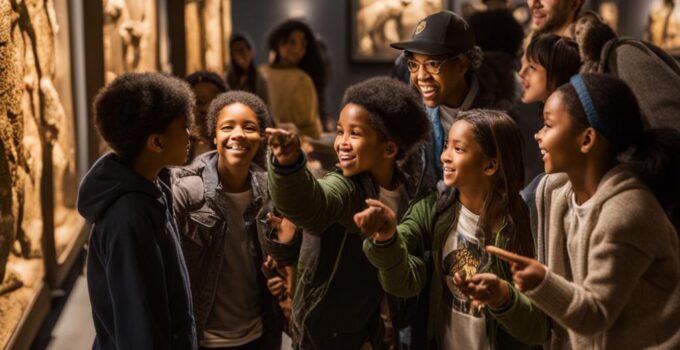
Field Trip Fundamentals: Understanding the Essence of Educational Visits
Table of Contents
Welcome to our comprehensive guide on educational visits, also known as field trips, and their importance in the learning journey of students. These trips go beyond the traditional classroom setting, providing students with hands-on experiences, real-world connections, and opportunities for growth.
Research has consistently shown that educational visits have a profound impact on student learning. Through experiential learning, students develop a deeper understanding of the concepts taught in the classroom and gain valuable knowledge. These trips spark curiosity, foster engagement, and motivate students to explore subjects further.
Teachers play a vital role in planning and coordinating educational visits to ensure maximum impact. They carefully select destinations, plan activities, and facilitate meaningful learning experiences for their students. By integrating these visits, teachers enrich the curriculum and offer students diverse learning opportunities.
Key Takeaways:
- Educational visits, or field trips, enhance student learning by providing hands-on experiences.
- Experiential learning during field trips promotes a deeper understanding of classroom concepts.
- Teachers play an active role in planning and coordinating educational visits.
- Educational visits enrich the curriculum and offer students diverse learning opportunities.
- Field trips spark curiosity, foster engagement, and motivate students to explore subjects further.
The Importance of Experiential Learning
Experiential learning is a key aspect of educational visits. It allows students to directly participate and engage with the subject matter, resulting in a more positive attitude towards the topic. Numerous studies have shown that students who participate in field trips gain valuable knowledge and develop a deeper understanding of the concepts they learn in the classroom. Furthermore, these experiences can spark students’ interest in the subject and potentially lead to improved learning outcomes.
The Benefits of Experiential Learning
During educational visits, students have the opportunity to apply theoretical knowledge in practical ways. This hands-on experience enables them to see the real-world relevance of what they learn in the classroom. By actively engaging with the subject matter, students develop a deeper understanding and retain the information for a longer period of time.
Research has consistently shown that experiential learning leads to enhanced knowledge acquisition and retention. For example, a study conducted by Smith et al. (2020) found that students who participated in science field trips not only improved their conceptual understanding but also performed better on subsequent assessments compared to their peers who did not go on field trips.
Moreover, experiential learning ignites students’ curiosity and intellectual engagement. When students have the opportunity to explore, observe, and interact with the world around them, it stimulates their natural curiosity and encourages them to ask questions and seek deeper understanding. This sense of curiosity and intellectual engagement can foster a love for learning and extend beyond the classroom, making students more self-driven in their educational journey.
Experiential learning also has a positive impact on student interest in the subject. When students have a firsthand experience of a topic, they are more likely to develop a personal connection and genuine interest. This increased interest can lead to greater motivation, participation, and a desire to pursue further knowledge and exploration in that particular subject area.
To further illustrate the importance of experiential learning, let’s take a look at a real-world example:
This immersive experience allows students to develop a deeper understanding of marine biology concepts, appreciate the complexity of marine ecosystems, and witness the real-world impact of science. By engaging in experiential learning, students not only acquire knowledge but also develop critical thinking, problem-solving, and collaboration skills that are essential for their future success.
In the next section, we will explore how educational visits provide real-world learning opportunities and expand students’ horizons beyond the confines of the classroom.
Real World Learning Through Field Trips
Field trips offer students a unique opportunity to gain real-world experience and engage in hands-on learning outside the classroom. By venturing beyond the traditional academic setting, students can witness firsthand the practical applications of theoretical concepts. These educational visits to captivating field trip destinations allow students to experience the rich cultural heritage and natural beauty of different locations, leaving a lasting impact on their understanding and appreciation of the subject matter.
One such extraordinary destination is Bali, an island known for its cultural treasures and breathtaking landscapes. Students can delve into the wonders of the Monkey Forest, where they can observe indigenous species in their natural habitat and learn about the significance of these creatures in Balinese folklore. Another remarkable field trip destination in Bali is the Ulun Danu Bratan Temple, a sacred Hindu temple located on the shores of Lake Bratan. Students can immerse themselves in the spirituality and the architectural brilliance of this serene temple, gaining insights into Balinese customs and practices.
These field trips offer students more than just a change of scenery; they provide them with real experiences and interactive learning opportunities that stimulate curiosity and foster a deeper understanding of the subject matter. Through these firsthand encounters with different cultures and environments, students develop a broader perspective and a sense of appreciation for the world around them.
Let’s take a closer look at how real-world experience and hands-on learning during educational visits can impact student learning:
Benefits of Real-World Experience
Table: Key Benefits of Real-World Experience
Real-world experience through field trips provides students with a multidimensional learning experience that cannot be replicated within the confines of a classroom. As they explore field trip destinations like Bali’s Monkey Forest and Ulun Danu Bratan Temple, students engage with real-life examples of the subjects they study, creating lasting memories and a deep connection to the material. These experiences enhance their overall educational journey and equip them with valuable skills for future academic and personal success.
Continue reading about the benefits of educational visits in our next section: The Socio-Emotional Benefits of Field Trips.
The Socio-Emotional Benefits of Field Trips
Field trips offer more than just academic learning; they also provide valuable socio-emotional benefits for students. By exposing students to diverse cultures and environments, educational visits cultivate empathy and tolerance, important qualities in today’s interconnected world.
Interacting with individuals from different backgrounds fosters empathy, allowing students to develop a deeper understanding and appreciation for others’ perspectives and experiences. Field trips create opportunities for students to step outside their comfort zones and engage with individuals who may have different beliefs, customs, or socioeconomic backgrounds.
Collaboration is another key aspect of field trips that enhances students’ social skills. Working together with their peers and adult guides during educational visits promotes effective communication, teamwork, and problem-solving. Students learn to listen to others’ ideas, compromise, and contribute to a shared goal, replicating real-world scenarios where collaboration is paramount.
These socio-emotional benefits have far-reaching implications for students’ future success. Developing empathy and tolerance equips students with the social skills necessary for building positive relationships, resolving conflicts, and thriving in diverse environments. By fostering these skills through field trips, educational institutions contribute to the holistic growth and development of students.
Examples of Socio-Emotional Benefits:
- Increased empathy and understanding of different cultures
- Enhanced tolerance towards others’ perspectives and experiences
- Improved communication and teamwork skills
- Development of problem-solving abilities
By embracing field trips as an integral part of education, we nurture the socio-emotional growth of students, promoting a more compassionate and inclusive society.
Academic Impact of Field Trips
Research has consistently shown the significant impact of field trips on students’ academic performance. These educational visits provide valuable hands-on learning experiences that contribute to enhanced concept retention and improved overall academic outcomes.
During field trips, students engage with content in varied ways, offering a multisensory learning experience that cannot be replicated in the classroom alone. This active participation allows students to apply theoretical knowledge to real-world contexts, deepening their understanding of the subject matter.
Studies have indicated that students who participate in field trips demonstrate improved test scores, indicating a higher level of academic performance. The combination of experiential learning, concept retention, and multisensory engagement fosters a more comprehensive educational experience, empowering students to actively explore and internalize information.
Benefits of Field Trips for Academic Performance:
- Enhanced concept retention through hands-on learning experiences
- Improved test scores and academic performance
- Deeper understanding of subject matter
- Application of theoretical knowledge in real-world contexts
- Engagement with content through multisensory learning
In summary, field trips have a profound impact on students’ academic performance by providing them with immersive learning experiences that promote concept retention and foster a deeper understanding of the subject matter. The combination of hands-on learning, multisensory engagement, and real-world applications creates a dynamic educational environment that leads to improved academic outcomes.
Enriching the Curriculum Through Field Trips
Field trips provide an opportunity to enrich the curriculum and offer students a more comprehensive learning experience. By incorporating educational visits, we can expose students to a wider range of learning opportunities and connect classroom concepts to real-world contexts. These diverse experiences allow students to gain a deeper understanding of the curriculum and make meaningful connections between different subjects.
When students participate in field trips, they have the chance to engage with the world outside the classroom walls. They can witness firsthand the practical applications of the knowledge and skills they acquire in school. Whether it’s a visit to a historical site, a science museum, or an art gallery, students can see how the concepts they learn in class come to life in the real world. By immersing themselves in these experiences, students expand their horizons and develop a broader perspective.
Field trips also provide an opportunity for curriculum expansion. Teachers have the flexibility to tailor the curriculum to the specific needs and interests of their students. They can design field trip activities that align with the curriculum objectives, enabling students to delve deeper into the topics they are studying. For example, a science field trip to a nature reserve can expand on biology lessons by allowing students to observe and study different ecosystems and the biodiversity within them.
Furthermore, field trips foster a multidisciplinary approach to learning. Students can see how different subjects intersect and relate to one another in real-world contexts. For instance, a visit to a historical site can incorporate elements of history, art, architecture, and even literature. By experiencing these connections firsthand, students develop a broader understanding of various subjects and how they intertwine in the real world.
Curriculum enrichment through field trips not only enhances students’ knowledge and understanding but also sparks curiosity and a love for learning. Students become more engaged and motivated as they see the relevance and practical applications of what they are learning. By broadening their educational experiences, we help students develop a thirst for knowledge that extends beyond the traditional confines of the classroom.
Benefits of Curriculum Enrichment through Field Trips:
- Enhanced understanding of curriculum concepts
- Meaningful connections between different subjects
- Flexibility to tailor the curriculum to student needs
- Promotion of multidisciplinary learning
- Increased student engagement and motivation
Curriculum enrichment through field trips is an invaluable tool in providing students with comprehensive learning experiences. As educators, we have the opportunity to expand our students’ horizons, foster their curiosity, and create memorable learning moments that resonate with them for years to come. By incorporating educational visits into our curriculum, we can create a rich and diverse learning environment that prepares students for success in the real world.
Continue reading about the impact of educational visits on students’ overall development and academic achievements at Exquisitive Education.
Building Lifelong Memories Through Field Trips
Field trips offer students the opportunity to create lasting memories that will stay with them for years to come. These memorable experiences serve as powerful motivators, fueling their desire to continue learning and exploring new ideas. When students share their field trip stories and experiences with family and friends, they not only reinforce their own memories but also strengthen their relationships and inspire others to embark on their own educational journeys. Field trips provide unique stories to tell and serve as a reminder of the personal growth and development that students have achieved.
Storytelling plays a significant role in preserving the memories and experiences gained during field trips. As students recount their adventures, they reinforce the knowledge and connections they formed during the trip, deepening their understanding of the subject matter. Furthermore, storytelling allows students to reflect on their own personal growth and highlight the transformative impact that field trips had on their lives.
Benefits of Building Lifelong Memories Through Field Trips
The essence of educational visits.
Educational visits, also known as field trips, offer students a hands-on experience that goes beyond the confines of the classroom. These visits provide students with the opportunity to explore and interact with different environments, cultures, and ideas. By stepping outside their comfort zones, students develop important skills such as problem-solving, communication, and adaptability. Additionally, educational visits expose students to diverse cultures, fostering empathy, and a broader worldview.
When students engage in educational visits, they have the chance to apply their knowledge in real-world contexts. Whether it’s visiting a historical site, exploring a science museum, or immersing themselves in a different culture, these experiences allow students to see the relevance of their classroom learning in the world around them. The hands-on nature of educational visits also enhances students’ understanding and retention of the subject matter.
Moreover, educational visits provide students with exposure to different cultures, fostering a sense of empathy and understanding. By interacting with people from diverse backgrounds, students develop a deeper appreciation for different perspectives and ways of life. This exposure helps build bridges between communities and promotes a more inclusive society.
Benefits of Educational Visits:
- Hands-on Experience: Educational visits provide students with practical, experiential learning opportunities that deepen their understanding.
- Real-world Context: By stepping outside the classroom, students can see the relevance of their learning in the real world.
- Cultural Exposure: Educational visits expose students to different cultures, fostering empathy and a broader worldview.
- Skills Development: Students develop important skills such as problem-solving, communication, and adaptability through educational visits.
- Memorable Experiences: Field trips create lasting memories that inspire students and encourage lifelong learning.
Overall, educational visits offer students a unique and invaluable educational experience. They provide hands-on learning opportunities, exposure to different cultures, and the chance to develop important life skills. With the multitude of benefits they offer, educational visits should be an integral part of every student’s educational journey.
Benefits for Teachers and Parents
Educational visits offer numerous benefits not only for students but also for teachers and parents. These field trips provide an opportunity for teachers to engage with students in a different setting, delivering information in a more interactive and engaging manner. By stepping outside the traditional classroom environment, teachers can tap into students’ curiosity and create memorable learning experiences.
Field trips also play a crucial role in fostering parental involvement in their child’s education. Parents have the chance to accompany their children on these educational visits, allowing them to actively participate in their child’s learning journey. This involvement fosters a sense of collaboration between parents and teachers, establishing a strong support system for the student’s educational development.
Moreover, educational visits demonstrate a commitment to providing students with a well-rounded education that extends beyond the classroom. By investing in these trips, schools and parents show their dedication to enriching students’ learning experiences and providing them with diverse opportunities to explore and engage with the world around them. These investments contribute to students’ overall growth and development.
Teacher Engagement
Educational visits rejuvenate teachers’ passion for teaching by allowing them to experiment with innovative teaching methods and interact with students outside of the usual academic environment. Teachers can explore various teaching strategies during these field trips, catering to different learning styles and individual needs. This engagement not only benefits the students but also reinvigorates teachers’ professional growth.
Parental Involvement
Field trips offer parents a unique chance to actively participate in their child’s education. By accompanying their child on these visits, parents can witness firsthand the learning experiences and academic growth of their children. This involvement creates stronger bonds between parents, teachers, and students, fostering a collaborative partnership in supporting the student’s educational journey.
Educational Investment
Investing in educational trips showcases a commitment to providing students with a comprehensive and holistic education. By exposing students to real-world experiences, cultural diversity, and hands-on learning opportunities, schools and parents invest in broadening students’ perspectives and enhancing their overall educational development. These investments contribute to students’ lifelong learning and equip them with the skills and knowledge necessary for future success.
The Value of Educational Visits
Educational visits have immense value in shaping students’ educational journey. They provide students with unique learning experiences that foster curiosity, empathy, and a deeper understanding of the world around them. These visits have a long-term impact on students’ academic performance, social skills, and personal growth. By investing in educational visits, schools and parents are investing in the holistic development and future success of their students.
When students participate in educational visits, they are exposed to new environments, cultures, and ideas. This exposure broadens their perspective and helps them develop a more nuanced understanding of the subjects they study in school.
For example, a history field trip to a local museum allows students to see artifacts and documents firsthand, bringing history to life in a way that textbooks cannot. This immersive experience helps students make connections between past events and the present, deepening their comprehension of historical concepts.
Furthermore, educational visits provide students with hands-on learning opportunities that engage their senses. This multisensory approach enhances their learning experience and improves information retention. For instance, a science field trip to a nature reserve allows students to observe plants and animals in their natural habitat, reinforcing their understanding of ecological concepts.
Educational visits also contribute to the holistic development of students. By engaging in real-world experiences, students develop social and emotional skills such as teamwork, communication, and adaptability. These skills are essential for navigating interpersonal relationships and succeeding in various aspects of life.
In summary, the value of educational visits cannot be underestimated. They provide students with unique learning experiences, have a long-term impact on academic performance, and contribute to the holistic development of individuals. Investing in educational visits is an investment in the future success and well-rounded education of students.
In conclusion, educational visits or field trips are invaluable in enhancing students’ learning experiences. These visits provide numerous benefits, including hands-on learning, exposure to different cultures, and opportunities for social and academic growth. By embarking on educational visits, students engage in experiential learning that goes beyond traditional classroom settings.
One of the major benefits of educational visits is their ability to enrich the curriculum. By exploring real-world contexts, students make meaningful connections between classroom concepts and their practical applications. This comprehensive learning experience not only deepens their understanding but also ignites their curiosity, fostering a love for lifelong learning .
Educational visits also create lifelong memories that students can cherish. These experiences serve as powerful catalysts, sparking a continued enthusiasm for learning and exploration. Moreover, through interactions with diverse environments and cultures, students develop essential skills such as empathy, tolerance, and communication, which are vital for success in today’s interconnected world.
Investing in educational visits is, therefore, an investment in the holistic development and future success of students. Through these transformative experiences, students gain valuable knowledge, skills, and a broader worldview that extends far beyond the confines of the classroom, enabling them to thrive in an ever-evolving, global society.
About The Author
Ethan Emerson
Ethan Emerson is a passionate author and dedicated advocate for the transformative power of education. With a background in teaching and a love for writing, Ethan brings a unique blend of expertise and creativity to his contributions on ExquisitiveEducation.com .His articles are a delightful mix of insightful knowledge and engaging storytelling, aiming to inspire and empower learners of all ages. Ethan's mission is to ignite the spark of curiosity and foster a love for learning in every reader.Ethan Emerson, is your companion in the realm of general education exploration. With a passion for knowledge, He delves into the intricate world of Education Expenses & Discounts , uncovering financial insights for your educational journey. From the vitality of Physical Education to the synergy of Education & Technology , Ethan's here to bridge the gap between traditional and innovative learning methods. Discover the art of crafting impressive Resume & Personal Documentation in Education , as well as insights into diverse Career Paths, Degrees & Educational Requirements . Join Ethan in navigating through a sea of Educational Courses & Classes , exploring the nuances of various Education Systems , and understanding the empowering realm of Special Education . With an eye on Teaching & Teachers , He offers a glimpse into the world of educators who shape minds. Let's unlock Studying Tips & Learning Methods that turn education into a delightful journey of growth with Exquisitive Education .
Related Posts

Understanding What is Performance Criteria in Education

Understanding What Does LLD Mean in Education: A Guide for You

Uncover the Secrets: What is Spontaneous Learning – A Guide
Leave a reply cancel reply.
Save my name, email, and website in this browser for the next time I comment.

- The Journal
- Vol. 14, No. 1
The Educational Value of Field Trips
Jay P. Greene
Brian Kisida
Daniel H. Bowen
Jay P. Greene joined EdNext Editor-in-chief Marty West to discuss the benefits of field trips, including how seeing live theater is a more enriching experience to students, on the EdNext podcast .
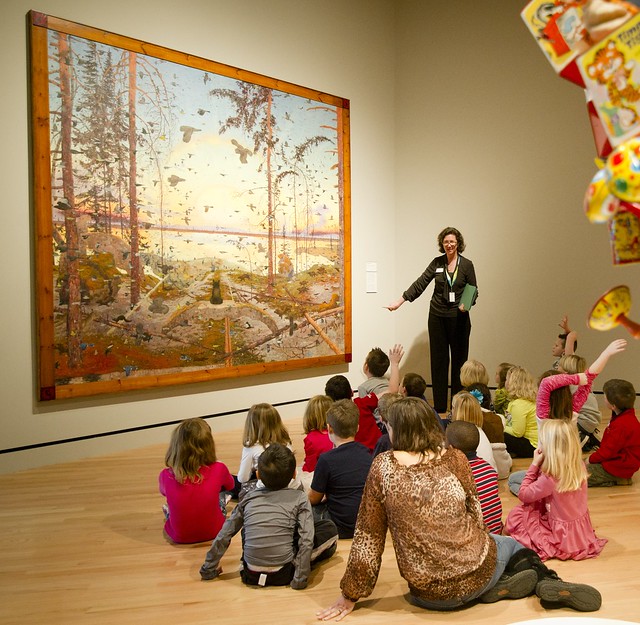
Crystal Bridges; Crystal Bridges Museum of American Art; School Tour © 2013 Stephen Ironside/Ironside Photography Bo Bartlett – “The Box” – 2002 • Oil on Linen • 82 x 100 – Photographer is Karen Mauch
The school field trip has a long history in American public education. For decades, students have piled into yellow buses to visit a variety of cultural institutions, including art, natural history, and science museums, as well as theaters, zoos, and historical sites. Schools gladly endured the expense and disruption of providing field trips because they saw these experiences as central to their educational mission: schools exist not only to provide economically useful skills in numeracy and literacy, but also to produce civilized young men and women who would appreciate the arts and culture. More-advantaged families may take their children to these cultural institutions outside of school hours, but less-advantaged students are less likely to have these experiences if schools do not provide them. With field trips, public schools viewed themselves as the great equalizer in terms of access to our cultural heritage.
Today, culturally enriching field trips are in decline. Museums across the country report a steep drop in school tours. For example, the Field Museum in Chicago at one time welcomed more than 300,000 students every year. Recently the number is below 200,000. Between 2002 and 2007, Cincinnati arts organizations saw a 30 percent decrease in student attendance. A survey by the American Association of School Administrators found that more than half of schools eliminated planned field trips in 2010–11.
The decision to reduce culturally enriching field trips reflects a variety of factors. Financial pressures force schools to make difficult decisions about how to allocate scarce resources, and field trips are increasingly seen as an unnecessary frill. Greater focus on raising student performance on math and reading standardized tests may also lead schools to cut field trips. Some schools believe that student time would be better spent in the classroom preparing for the exams. When schools do organize field trips, they are increasingly choosing to take students on trips to reward them for working hard to improve their test scores rather than to provide cultural enrichment. Schools take students to amusement parks, sporting events, and movie theaters instead of to museums and historical sites. This shift from “enrichment” to “reward” field trips is reflected in a generational change among teachers about the purposes of these outings. In a 2012‒13 survey we conducted of nearly 500 Arkansas teachers, those who had been teaching for at least 15 years were significantly more likely to believe that the primary purpose of a field trip is to provide a learning opportunity, while more junior teachers were more likely to see the primary purpose as “enjoyment.”
If schools are de-emphasizing culturally enriching field trips, has anything been lost as a result? Surprisingly, we have relatively little rigorous evidence about how field trips affect students. The research presented here is the first large-scale randomized-control trial designed to measure what students learn from school tours of an art museum.
We find that students learn quite a lot. In particular, enriching field trips contribute to the development of students into civilized young men and women who possess more knowledge about art, have stronger critical-thinking skills, exhibit increased historical empathy, display higher levels of tolerance, and have a greater taste for consuming art and culture.
Design of the Study and School Tours
The 2011 opening of the Crystal Bridges Museum of American Art in Northwest Arkansas created the opportunity for this study. Crystal Bridges is the first major art museum to be built in the United States in the last four decades, with more than 50,000 square feet of gallery space and an endowment in excess of $800 million. Portions of the museum’s endowment are devoted to covering all of the expenses associated with school tours. Crystal Bridges reimburses schools for the cost of buses, provides free admission and lunch, and even pays for the cost of substitute teachers to cover for teachers who accompany students on the tour.
Because the tour is completely free to schools, and because Crystal Bridges was built in an area that never previously had an art museum, there was high demand for school tours. Not all school groups could be accommodated right away. So our research team worked with the staff at Crystal Bridges to assign spots for school tours by lottery. During the first two semesters of the school tour program, the museum received 525 applications from school groups representing 38,347 students in kindergarten through grade 12. We created matched pairs among the applicant groups based on similarity in grade level and other demographic factors. An ideal and common matched pair would be adjacent grades in the same school. We then randomly ordered the matched pairs to determine scheduling prioritization. Within each pair, we randomly assigned which applicant would be in the treatment group and receive a tour that semester and which would be in the control group and have its tour deferred.
We administered surveys to 10,912 students and 489 teachers at 123 different schools three weeks, on average, after the treatment group received its tour. The student surveys included multiple items assessing knowledge about art as well as measures of critical thinking, historical empathy, tolerance, and sustained interest in visiting art museums. Some groups were surveyed as late as eight weeks after the tour, but it was not possible to collect data after longer periods because each control group was guaranteed a tour during the following semester as a reward for its cooperation. There is no indication that the results reported below faded for groups surveyed after longer periods.
We also assessed students’ critical-thinking skills by asking them to write a short essay in response to a painting that they had not previously seen. Finally, we collected a behavioral measure of interest in art consumption by providing all students with a coded coupon good for free family admission to a special exhibit at the museum to see whether the field trip increased the likelihood of students making future visits.
All results reported below are derived from regression models that control for student grade level and gender and make comparisons within each matched pair, while taking into account the fact that students in the matched pair of applicant groups are likely to be similar in ways that we are unable to observe. Standard validity tests confirmed that the survey items employed to generate the various scales used as outcomes measured the same underlying constructs.
The intervention we studied is a modest one. Students received a one-hour tour of the museum in which they typically viewed and discussed five paintings. Some students were free to roam the museum following their formal tour, but the entire experience usually involved less than half a day. Instructional materials were sent to teachers who went on a tour, but our survey of teachers suggests that these materials received relatively little attention, on average no more than an hour of total class time. The discussion of each painting during the tour was largely student-directed, with the museum educators facilitating the discourse and providing commentary beyond the names of the work and the artist and a brief description only when students requested it. This format is now the norm in school tours of art museums. The aversion to having museum educators provide information about works of art is motivated in part by progressive education theories and by a conviction among many in museum education that students retain very little factual information from their tours.
Recalling Tour Details. Our research suggests that students actually retain a great deal of factual information from their tours. Students who received a tour of the museum were able to recall details about the paintings they had seen at very high rates. For example, 88 percent of the students who saw the Eastman Johnson painting At the Camp—Spinning Yarns and Whittling knew when surveyed weeks later that the painting depicts abolitionists making maple syrup to undermine the sugar industry, which relied on slave labor. Similarly, 82 percent of those who saw Norman Rockwell’s Rosie the Riveter could recall that the painting emphasizes the importance of women entering the workforce during World War II. Among students who saw Thomas Hart Benton’s Ploughing It Under , 79 percent recollected that it is a depiction of a farmer destroying his crops as part of a Depression-era price support program. And 70 percent of the students who saw Romare Bearden’s Sacrifice could remember that it is part of the Harlem Renaissance art movement. Since there was no guarantee that these facts would be raised in student-directed discussions, and because students had no particular reason for remembering these details (there was no test or grade associated with the tours), it is impressive that they could recall historical and sociological information at such high rates.
These results suggest that art could be an important tool for effectively conveying traditional academic content, but this analysis cannot prove it. The control-group performance was hardly better than chance in identifying factual information about these paintings, but they never had the opportunity to learn the material. The high rate of recall of factual information by students who toured the museum demonstrates that the tours made an impression. The students could remember important details about what they saw and discussed.
Critical Thinking. Beyond recalling the details of their tour, did a visit to an art museum have a significant effect on students? Our study demonstrates that it did. For example, students randomly assigned to receive a school tour of Crystal Bridges later displayed demonstrably stronger ability to think critically about art than the control group.
During the first semester of the study, we showed all 3rd- through 12th-grade students a painting they had not previously seen, Bo Bartlett’s The Box . We then asked students to write short essays in response to two questions: What do you think is going on in this painting? And, what do you see that makes you think that? These are standard prompts used by museum educators to spark discussion during school tours.
We stripped the essays of all identifying information and had two coders rate the compositions using a seven-item rubric for measuring critical thinking that was developed by researchers at the Isabella Stewart Gardner Museum in Boston. The measure is based on the number of instances that students engaged in the following in their essays: observing, interpreting, evaluating, associating, problem finding, comparing, and flexible thinking. Our measure of critical thinking is the sum of the counts of these seven items. In total, our research team blindly scored 3,811 essays. For 750 of those essays, two researchers scored them independently. The scores they assigned to the same essay were very similar, demonstrating that we were able to measure critical thinking about art with a high degree of inter-coder reliability.
We express the impact of a school tour of Crystal Bridges on critical-thinking skills in terms of standard-deviation effect sizes. Overall, we find that students assigned by lottery to a tour of the museum improve their ability to think critically about art by 9 percent of a standard deviation relative to the control group. The benefit for disadvantaged groups is considerably larger (see Figure 1). Rural students, who live in towns with fewer than 10,000 people, experience an increase in critical-thinking skills of nearly one-third of a standard deviation. Students from high-poverty schools (those where more than 50 percent of students receive free or reduced-price lunches) experience an 18 percent effect-size improvement in critical thinking about art, as do minority students.
A large amount of the gain in critical-thinking skills stems from an increase in the number of observations that students made in their essays. Students who went on a tour became more observant, noticing and describing more details in an image. Being observant and paying attention to detail is an important and highly useful skill that students learn when they study and discuss works of art. Additional research is required to determine if the gains in critical thinking when analyzing a work of art would transfer into improved critical thinking about other, non-art-related subjects.
Historical Empathy. Tours of art museums also affect students’ values. Visiting an art museum exposes students to a diversity of ideas, peoples, places, and time periods. That broadening experience imparts greater appreciation and understanding. We see the effects in significantly higher historical empathy and tolerance measures among students randomly assigned to a school tour of Crystal Bridges.
Historical empathy is the ability to understand and appreciate what life was like for people who lived in a different time and place. This is a central purpose of teaching history, as it provides students with a clearer perspective about their own time and place. To measure historical empathy, we included three statements on the survey with which students could express their level of agreement or disagreement: 1) I have a good understanding of how early Americans thought and felt; 2) I can imagine what life was like for people 100 years ago; and 3) When looking at a painting that shows people, I try to imagine what those people are thinking. We combined these items into a scale measuring historical empathy.
Students who went on a tour of Crystal Bridges experience a 6 percent of a standard deviation increase in historical empathy. Among rural students, the benefit is much larger, a 15 percent of a standard deviation gain. We can illustrate this benefit by focusing on one of the items in the historical empathy scale. When asked to agree or disagree with the statement, “I have a good understanding of how early Americans thought and felt,” 70 percent of the treatment-group students express agreement compared to 66 percent of the control group. Among rural participants, 69 percent of the treatment-group students agree with this statement compared to 62 percent of the control group. The fact that Crystal Bridges features art from different periods in American history may have helped produce these gains in historical empathy.
Tolerance. To measure tolerance we included four statements on the survey to which students could express their level of agreement or disagreement: 1) People who disagree with my point of view bother me; 2) Artists whose work is critical of America should not be allowed to have their work shown in art museums; 3) I appreciate hearing views different from my own; and 4) I think people can have different opinions about the same thing. We combined these items into a scale measuring the general effect of the tour on tolerance.
Overall, receiving a school tour of an art museum increases student tolerance by 7 percent of a standard deviation. As with critical thinking, the benefits are much larger for students in disadvantaged groups. Rural students who visited Crystal Bridges experience a 13 percent of a standard deviation improvement in tolerance. For students at high-poverty schools, the benefit is 9 percent of a standard deviation.
The improvement in tolerance for students who went on a tour of Crystal Bridges can be illustrated by the responses to one of the items within the tolerance scale. When asked about the statement, “Artists whose work is critical of America should not be allowed to have their work shown in art museums,” 35 percent of the control-group students express agreement. But for students randomly assigned to receive a school tour of the art museum, only 32 percent agree with censoring art critical of America. Among rural students, 34 percent of the control group would censor art compared to 30 percent for the treatment group. In high-poverty schools, 37 percent of the control-group students would censor compared to 32 percent of the treatment-group students. These differences are not huge, but neither is the intervention. These changes represent the realistic improvement in tolerance that results from a half-day experience at an art museum.
Interest in Art Museums. Perhaps the most important outcome of a school tour is whether it cultivates an interest among students in returning to cultural institutions in the future. If visiting a museum helps improve critical thinking, historical empathy, tolerance, and other outcomes not measured in this study, then those benefits would compound for students if they were more likely to frequent similar cultural institutions throughout their life. The direct effects of a single visit are necessarily modest and may not persist, but if school tours help students become regular museum visitors, they may enjoy a lifetime of enhanced critical thinking, tolerance, and historical empathy.
We measured how school tours of Crystal Bridges develop in students an interest in visiting art museums in two ways: with survey items and a behavioral measure. We included a series of items in the survey designed to gauge student interest:
• I plan to visit art museums when I am an adult.
• I would tell my friends they should visit an art museum.
• Trips to art museums are interesting.
• Trips to art museums are fun.
• Would your friend like to go to an art museum on a field trip?
• Would you like more museums in your community?
• How interested are you in visiting art museums?
• If your friends or family wanted to go to an art museum, how interested would you be in going?
Interest in visiting art museums among students who toured the museum is 8 percent of a standard deviation higher than that in the randomized control group. Among rural students, the increase is much larger: 22 percent of a standard deviation. Students at high-poverty schools score 11 percent of a standard deviation higher on the cultural consumer scale if they were randomly assigned to tour the museum. And minority students gain 10 percent of a standard deviation in their desire to be art consumers.
One of the eight items in the art consumer scale asked students to express the extent to which they agreed or disagreed with the statement, “I would tell my friends they should visit an art museum.” For all students who received a tour, 70 percent agree with this statement, compared to 66 percent in the control group. Among rural participants, 73 percent of the treatment-group students agree versus 63 percent of the control group. In high-poverty schools, 74 percent would recommend art museums to their friends compared to 68 percent of the control group. And among minority students, 72 percent of those who received a tour would tell their friends to visit an art museum, relative to 67 percent of the control group. Students, particularly those from disadvantaged backgrounds, are more likely to have positive feelings about visiting museums if they receive a school tour.
We also measured whether students are more likely to visit Crystal Bridges in the future if they received a school tour. All students who participated in the study during the first semester, including those who did not receive a tour, were provided with a coupon that gave them and their families free entry to a special exhibit at Crystal Bridges. The coupons were coded so that we could determine the applicant group to which students belonged. Students had as long as six months after receipt of the coupon to use it.
We collected all redeemed coupons and were able to calculate how many adults and youths were admitted. Though students in the treatment group received 49 percent of all coupons that were distributed, 58 percent of the people admitted to the special exhibit with those coupons came from the treatment group. In other words, the families of students who received a tour were 18 percent more likely to return to the museum than we would expect if their rate of coupon use was the same as their share of distributed coupons.
This is particularly impressive given that the treatment-group students had recently visited the museum. Their desire to visit a museum might have been satiated, while the control group might have been curious to visit Crystal Bridges for the first time. Despite having recently been to the museum, students who received a school tour came back at higher rates. Receiving a school tour cultivates a taste for visiting art museums, and perhaps for sharing the experience with others.
Disadvantaged Students
One consistent pattern in our results is that the benefits of a school tour are generally much larger for students from less-advantaged backgrounds. Students from rural areas and high-poverty schools, as well as minority students, typically show gains that are two to three times larger than those of the total sample. Disadvantaged students assigned by lottery to receive a school tour of an art museum make exceptionally large gains in critical thinking, historical empathy, tolerance, and becoming art consumers.
It appears that the less prior exposure to culturally enriching experiences students have, the larger the benefit of receiving a school tour of a museum. We have some direct measures to support this explanation. To isolate the effect of the first time visiting the museum, we truncated our sample to include only control-group students who had never visited Crystal Bridges and treatment-group students who had visited for the first time during their tour. The effect for this first visit is roughly twice as large as that for the overall sample, just as it is for disadvantaged students.
In addition, we administered a different version of our survey to students in kindergarten through 2nd grade. Very young students are less likely to have had previous exposure to culturally enriching experiences. Very young students make exceptionally large improvements in the observed outcomes, just like disadvantaged students and first-time visitors.
When we examine effects for subgroups of advantaged students, we typically find much smaller or null effects. Students from large towns and low-poverty schools experience few significant gains from their school tour of an art museum. If schools do not provide culturally enriching experiences for these students, their families are likely to have the inclination and ability to provide those experiences on their own. But the families of disadvantaged students are less likely to substitute their own efforts when schools do not offer culturally enriching experiences. Disadvantaged students need their schools to take them on enriching field trips if they are likely to have these experiences at all.
Policy Implications
School field trips to cultural institutions have notable benefits. Students randomly assigned to receive a school tour of an art museum experience improvements in their knowledge of and ability to think critically about art, display stronger historical empathy, develop higher tolerance, and are more likely to visit such cultural institutions as art museums in the future. If schools cut field trips or switch to “reward” trips that visit less-enriching destinations, then these important educational opportunities are lost. It is particularly important that schools serving disadvantaged students provide culturally enriching field trip experiences.
This first-ever, large-scale, random-assignment experiment of the effects of school tours of an art museum should help inform the thinking of school administrators, educators, policymakers, and philanthropists. Policymakers should consider these results when deciding whether schools have sufficient resources and appropriate policy guidance to take their students on tours of cultural institutions. School administrators should give thought to these results when deciding whether to use their resources and time for these tours. And philanthropists should weigh these results when deciding whether to build and maintain these cultural institutions with quality educational programs. We don’t just want our children to acquire work skills from their education; we also want them to develop into civilized people who appreciate the breadth of human accomplishments. The school field trip is an important tool for meeting this goal.
Jay P. Greene is professor of education reform at the University of Arkansas, where Brian Kisida is a senior research associate and Daniel H. Bowen is a doctoral student.
Additional materials, including a supplemental study and a methodological appendix , are available.
For more, please see “ The Top 20 Education Next Articles of 2023 .”
This article appeared in the Winter 2014 issue of Education Next . Suggested citation format:
Greene, J.P., Kisida, B., and Bowen, D.H. (2014). The Educational Value of Field Trips: Taking students to an art museum improves critical thinking skills, and more . Education Next , 14(1), 78-86.
Last Updated
License this Content
Latest Issue
Summer 2024.
Vol. 24, No. 3
We Recommend You Read
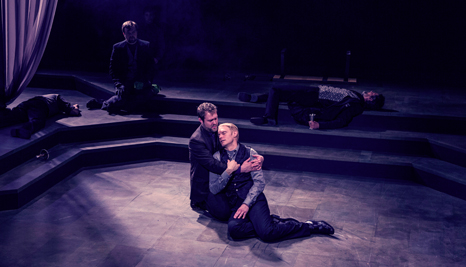
Learning from Live Theater
Students realize gains in knowledge, tolerance, and more
by Jay P. Greene
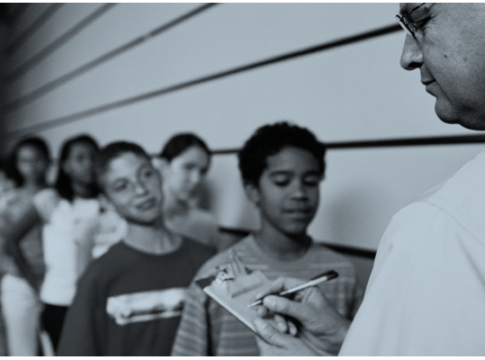
Getting Ahead by Staying Behind
An evaluation of Florida’s program to end social promotion
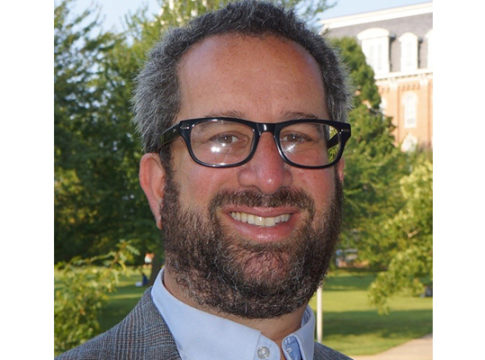
Straight Up Conversation: Scholar Jay Greene on the Importance of Field Trips
by Frederick Hess
- Daily Crossword
- Word Puzzle
- Word Finder
- Word of the Day
- Synonym of the Day
- Word of the Year
- Language stories
- All featured
- Gender and sexuality
- All pop culture
- Writing hub
- Grammar essentials
- Commonly confused
- All writing tips
- Pop culture
- Writing tips
Advertisement
- a trip by students to gain firsthand knowledge away from the classroom, as to a museum, factory, geological area, or environment of certain plants and animals.
- a trip by a scholar or researcher to gather data firsthand, as to a geological, archaeological, anthropological, or other site.
- an expedition, as by a group of students or research workers, to study something at first hand
Word History and Origins
Origin of field trip 1
Example Sentences
Ali, who works with younger students in the program, recalls a field trip in which the children asked for ice cream.
They have already planned field trips to local parks and ordered biology labs.
Even a recent outing to a retail store was a thrilling field trip for the family, he says.
While I would like to think I chose the latter out of self-reflection and an aversion to the status quo, I think the decision was more about the promise of having less homework and more field trips.
He plans to use the winnings to pay off some of his student loans and help pay for supplies and field trips for his students.
“The highlight was a school field trip that came specially to see Bach in the Subways who were perfectly behaved,” he says.
Standing in the dark, I felt lost, like the time I wandered off by myself on a second-grade field trip to the history museum.
When I was in junior high, our 8th grade class took a field trip to Florida.
Not to be missed: Chris Farley as the angry bus driver taking the kids on a field trip.
Shandee, a student on a geology field trip, finds a disembodied—but talkative—arm in a quarry.
On a field trip he had undertaken as a student, the young engineer inadvertently stumbled across a treasure in manganese.
Field trip planned to show that insects feed upon plants; make their homes upon plants.
If possible let the children take a field trip in connection with these lessons.
Other modifications of these forms may easily be found on any field trip.
At least one field trip must be planned for the month of May.
The Enlightened Mindset
Exploring the World of Knowledge and Understanding
Welcome to the world's first fully AI generated website!
The Benefits of Field Trips: Why They Are Important for Education
By Happy Sharer
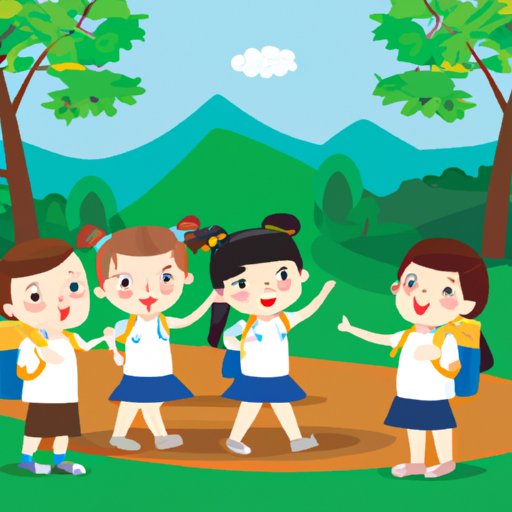
Introduction
Field trips have been a staple of education for centuries. From school trips to museums, historical sites, and outdoor activities, field trips offer students an opportunity to learn in a unique and engaging environment outside of the traditional classroom. Field trips can provide students with invaluable experiences that promote learning, encourage exploration, and inspire creativity. In this article, we will explore why field trips are important and how they can help solve the problem of student engagement.
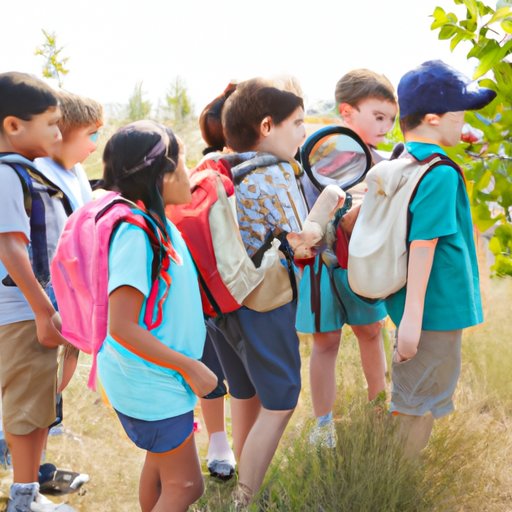
Examining the Educational Benefits of Field Trips
Field trips offer a number of educational benefits that cannot be replicated in a classroom setting. By participating in field trips, students gain hands-on experience, introduce new ideas and perspectives, and enhance their learning through exploration.
Gaining Hands-on Experience
One of the most important benefits of field trips is that they provide students with hands-on experience. By visiting museums, historical sites, and other places of interest, students are able to interact with and explore objects and artifacts that may not be available in their classroom. Through these interactions, students can develop a deeper understanding of the material they are studying and gain a greater appreciation for the topic.
Introducing New Ideas and Perspectives
Another benefit of field trips is that they allow students to be exposed to new ideas and perspectives. By visiting different locations, students can observe the world around them in a way that is not possible in the classroom. This exposure to new environments and cultures can help students better understand the topics they are studying and gain a broader perspective on the world.
Enhancing Learning Through Exploration
Finally, field trips provide students with an opportunity to explore and discover new information. By engaging in activities such as scavenger hunts and interactive exhibits, students can engage in active learning and gain a deeper understanding of the material. This type of exploration encourages critical thinking and creative problem-solving, which can help students become more successful learners.
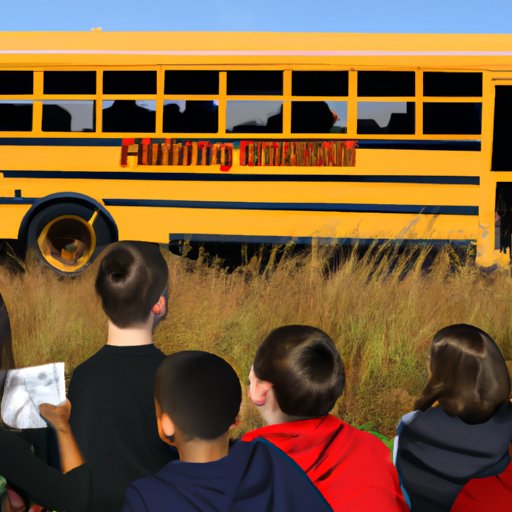
Exploring the Impact of Field Trips on Student Engagement
In addition to providing educational benefits, field trips can also help improve student engagement. By participating in field trips, students can develop motivation, enthusiasm, and a sense of confidence and self-esteem.
Improving Motivation and Enthusiasm
Field trips can help improve student motivation and enthusiasm by providing an engaging and stimulating learning environment. By participating in activities that are both fun and educational, students can become more engaged in their learning and be more likely to take an active role in the classroom.
Developing Social Skills
Field trips can also help students develop social skills. By interacting with their peers in a new environment, students can learn how to communicate and collaborate more effectively. This type of interaction can help students build relationships with their classmates, which can lead to increased engagement in the classroom.
Increasing Confidence and Self-Esteem
Finally, field trips can help increase student confidence and self-esteem. By participating in activities outside of the classroom, students can learn new skills, explore new ideas, and be exposed to new experiences. This type of learning can help students feel more confident in their abilities and be more willing to take risks in the classroom.
Experiencing History Firsthand Through Field Trips
Field trips can also provide students with the opportunity to experience history firsthand. By visiting historical sites and monuments, students can connect classroom lessons to real-world applications and gain a better understanding of historical events.
Connecting Classroom Lessons to Real-World Applications
By visiting historical sites, museums, and monuments, students can learn about the past in a more meaningful way. By seeing the artifacts and hearing firsthand accounts from experts, students can gain a better understanding of the events that shaped the world. This type of learning can help students make connections between what they are learning in the classroom and the real world.
Encouraging Students to Be Curious and Ask Questions
Field trips can also encourage students to be curious and ask questions. By exploring new environments and interacting with experts, students can gain a better understanding of the topics they are studying and be more likely to ask questions and seek out additional information. This type of curiosity can help students become more engaged in their learning and be more likely to take an active role in the classroom.
Understanding Historical Events in a More Meaningful Way
Finally, field trips can help students gain a deeper understanding of historical events. By visiting the places where these events took place, students can gain a better understanding of the people, places, and events that shaped the course of history. This type of learning can help students appreciate the importance of history and gain a greater understanding of the world around them.
Connecting Classroom Learning to Real-World Applications with Field Trips
Field trips can also help bridge the gap between classroom learning and real-world applications. By participating in field trips, students can apply theoretical knowledge to real-life situations, develop problem-solving and critical thinking skills, and build on existing knowledge and explore new topics.
Applying Theoretical Knowledge to Real-Life Situations
By participating in field trips, students can apply the theoretical knowledge they are learning in the classroom to real-life situations. By exploring different environments and interacting with experts, students can gain a better understanding of the topics they are studying and how they can be applied in the real world. This type of learning can help students become better problem-solvers and more effective communicators.
Developing Problem-Solving and Critical Thinking Skills
Field trips can also help students develop problem-solving and critical thinking skills. By engaging in activities such as scavenger hunts and interactive exhibits, students can practice critical thinking and develop strategies for solving complex problems. This type of learning can help students become more successful learners and be better prepared for the challenges of the real world.

Building on Existing Knowledge and Exploring New Topics
Finally, field trips can help students build on existing knowledge and explore new topics. By visiting different locations and engaging in activities, students can gain a deeper understanding of the material they are studying and be exposed to new ideas and perspectives. This type of exploration can help students become more informed citizens and better equipped to handle the challenges of the world.
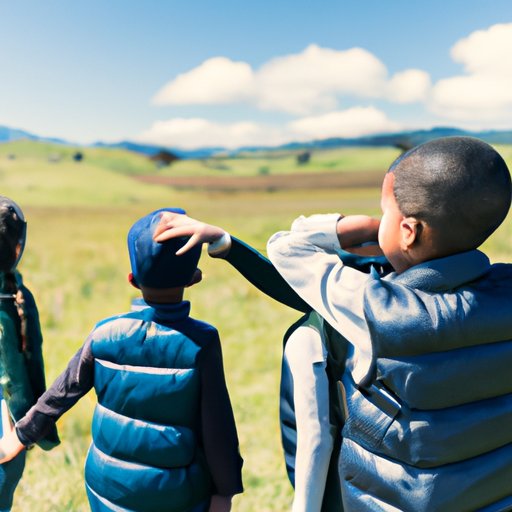
Cultivating Curiosity and Encouraging Exploration through Field Trips
Field trips can also help cultivate curiosity and encourage exploration. By participating in field trips, students can explore their interests, create opportunities for collaboration and teamwork, and be encouraged to think creatively and innovatively.
Allowing Students to Explore Their Interests
Field trips can provide students with the opportunity to explore their interests. By visiting different locations, students can gain a better understanding of the topics they are studying and be exposed to new ideas and perspectives. This type of exploration can help students become more informed citizens and better equipped to handle the challenges of the world.
Creating Opportunities for Collaboration and Teamwork
Field trips can also create opportunities for collaboration and teamwork. By participating in activities together, students can develop communication and collaboration skills that can help them in the classroom and beyond. This type of interaction can help students build relationships with their classmates, which can lead to increased engagement in the classroom.
Encouraging Creativity and Innovation
Finally, field trips can encourage creativity and innovation. By exploring new environments and interacting with experts, students can gain a better understanding of the topics they are studying and be inspired to think critically and creatively. This type of learning can help students become more successful learners and be better prepared for the challenges of the real world.
Understanding the Role of Field Trips in Social Development
In addition to providing educational benefits, field trips can also play an important role in social development. By participating in field trips, students can develop social awareness and empathy, strengthen communication and collaboration skills, and promote respect for diversity and cultural differences.
Developing Social Awareness and Empathy
Field trips can help students develop social awareness and empathy. By visiting different locations and interacting with peers and experts, students can gain a better understanding of the world around them and learn to appreciate the perspectives of others. This type of learning can help students become more empathetic and understanding citizens.
Strengthening Communication and Collaboration Skills
Field trips can also help students strengthen their communication and collaboration skills. By participating in activities together, students can learn how to work together more effectively and develop the skills needed to succeed in the classroom and beyond. This type of interaction can help students build relationships with their classmates, which can lead to increased engagement in the classroom.
Promoting Respect for Diversity and Cultural Differences
Finally, field trips can help promote respect for diversity and cultural differences. By visiting different locations and interacting with peers and experts, students can gain a better understanding of the world around them and learn to appreciate the perspectives of others. This type of learning can help students become more accepting of cultural differences and promote understanding and respect among their peers.
Field trips are an important part of education, offering students hands-on experience, introducing new perspectives, and improving student engagement. Field trips can also help students gain a better understanding of the topics they are studying, develop problem-solving and critical thinking skills, and cultivate curiosity and exploration. Finally, field trips can help students develop social awareness and empathy, strengthen communication and collaboration skills, and promote respect for diversity and cultural differences. For all these reasons, it is essential that field trips remain a priority in education.
(Note: Is this article not meeting your expectations? Do you have knowledge or insights to share? Unlock new opportunities and expand your reach by joining our authors team. Click Registration to join us and share your expertise with our readers.)
Hi, I'm Happy Sharer and I love sharing interesting and useful knowledge with others. I have a passion for learning and enjoy explaining complex concepts in a simple way.
Related Post
Exploring japan: a comprehensive guide for your memorable journey, your ultimate guide to packing for a perfect trip to hawaii, the ultimate packing checklist: essentials for a week-long work trip, leave a reply cancel reply.
Your email address will not be published. Required fields are marked *
Expert Guide: Removing Gel Nail Polish at Home Safely
Trading crypto in bull and bear markets: a comprehensive examination of the differences, making croatia travel arrangements, make their day extra special: celebrate with a customized cake.
Field Trips: Pros and Cons
Off-campus excursions can enhance learning, but they pose challenges
- Tips & Strategies
- An Introduction to Teaching
- Policies & Discipline
- Community Involvement
- School Administration
- Technology in the Classroom
- Teaching Adult Learners
- Issues In Education
- Teaching Resources
- Becoming A Teacher
- Assessments & Tests
- Elementary Education
- Secondary Education
- Special Education
- Homeschooling
- M.Ed., Curriculum and Instruction, University of Florida
- B.A., History, University of Florida
Are field trips worth all the time and effort required to make them successful? Most teachers have asked themselves this question at one time or another, typically when feeling overwhelmed as they prepare for a field trip. The truth is that field trips at any grade level can cause quite a few headaches for teachers. At the same time, well-planned field trips can provide students with truly educational experiences they cannot get in the confines of the classroom. Following is a look at the pros and cons of field trips.
Benefits of Field Trips
Field trips provide students with new opportunities for learning through experience:
Different Learning Modalities
Information is presented to students in a way that meets different learning modalities. Field trips provide students with the ability to learn by doing instead of just passively listening to the information being taught in class.
Students are exposed to new experiences that, hopefully, broaden their horizons. This can be especially helpful for students from lower socioeconomic backgrounds who may not have been exposed to these opportunities before.
Reinforcing Concepts
Concepts that have already been learned in the classroom can be reinforced. Sometimes seeing information being taught in a new way can make a big difference in student comprehension. There is quite a difference between being taught about something like hurricanes and wind speed and experiencing them in an exhibit at a science museum.
Shared Reference
Students are provided with shared reference points that teachers can then refer to and use in future lessons. There may be an opportunity to have two or more disciplines use a field trip as an enrichment activity. For example, a trip to an art museum (art) may couple with a timeline for social studies (political systems in place when art was created) or math (measurements) can combine with science in a biosystem (river, beach, and meadow). In this manner, several teachers can then refer to things that students saw and experienced during the field trip for the remainder of the school year.
Increased Student-Teacher Communication
Students and teachers can see each other in a different light, helping to increase communication between them. Some students who might be overlooked in class because they are quiet might really come alive on field trips.
If parents are involved as chaperones, they can feel more connected to the teacher and the lessons being taught. They can get to know the teacher better and understand what teachers deal with daily.
Meeting Standards
Standards in social studies and science require students to have experiences related to concepts in the discipline. In social studies, students are required to take informed action. In science, students need to be exposed to a series of concepts to help them to better understand the world around them. Field trips help teachers meet these objectives.
Problems With Field Trips
Teachers face a number of concerns and challenges when designing field trips that they need to recognize and address before planning a field trip.
Preparation Needed
Field trips take preparation if teachers want to make them meaningful. They have to coordinate locations and transportation. They also need to create an effective lesson plan that they will follow when on the excursion.
Students will be out of the school building for a field trip, which means they will miss other classes—at least in middle and high school. If each core subject area (ELA, math science, or social studies) offers one field trip during a school year, students would be out of the building for four days. School attendance policies may count these as excused absences, but any field trip that removes students from class reduces the number of classroom hours.
Trips Can Be Costly
Field trips can be expensive, and some students may not have the funds to attend. Organizers of the field trip may consider asking for parents to add a few dollars to help students in need. School boosters may need to host a fundraiser for students to raise money for more expensive trips.
Teachers have to organize the collection of money and the assigning of chaperones. Teachers need to spend some time creating student groups that work for all students and ensuring that chaperones are assigned accordingly.
Teachers will likely have to deal with red tape as they plan field trips including permission slips, medical information, and emergency procedures. Schools typically require paperwork from teachers and their students.
Potential Discipline Problems
Students will be placed in a larger environment than the classroom. New surroundings could possibly lead to additional discipline problems. Because teachers typically only lead a small group (such as 30 to 40 students), they may not be able to maintain control over the behavior of every student on the field trip, especially if the group is large. Teachers should go over rules and expectations before the field trip, enforce the rules strictly while away from school grounds, and create effective consequences for misbehavior.
May Be Disappointing
The field trip destination might not live up to the teacher's expectations. The location might not be as interesting as the teacher thought it would be. The time to complete the field trip might be considerably less than was expected. Therefore, it is a good idea to have some contingency plan in mind just in case.
There may be students who, for one reason or another, will not attend the field trip. Teachers must leave lessons, usually enrichment offerings, that mirror some of the concepts being experienced on the field trip.
Requesting Feedback
One of the best ways to measure the success of a field trip (other than returning all students back to the school) is to ask for feedback. Teachers can post a survey for participants and for other chaperones asking them to express how they would evaluate the trip.
Opportunity to Reflect
Students should have the opportunity to reflect on the trip and write a response in a journal or essay. Requiring journal responses after the trip can solidify the information learned as students reflect on their new experiences. Asking students to write a thank you to the school principal for allowing the trip may even smooth the path to additional field trips.
Worth the Difficulties
Many teachers feel that well-chosen field trip destinations are worth the difficulties they may create. The key is taking the time to plan each aspect as much as possible. Teachers should be proactive when thinking about and planning field trips. Students, on the other hand, may remember the experience of the school field trip as a highlight of the school year, and the time they learned more than anything taught in class.
- The Pros and Cons of Block Schedules
- Pros and Cons to Flexible Grouping in Middle and High School
- Teacher Housekeeping Tasks
- Bathroom Pass System for the Classroom
- Methods for Presenting Subject Matter
- What Teachers Do Beyond the Classroom When No One Is Looking
- The Importance of Organization for Teachers
- Classroom Procedures
- How Scaffolding Instruction Can Improve Comprehension
- Time-Filler Games for Every Classroom
- Dealing With Trips to the Bathroom During Class
- Improve Algebra Content Vocabulary with Poetry
- 4 Poetic Formulas for Geometry Class
- Classroom Rules for High School Students
- Classroom-Management Tips for Substitute Teachers
- Creating a Positive Learning Environment

Is There a Difference Between a Field Trip and an Educational Tour?
There is nothing more exhilarating for most students than hearing the news of an upcoming school trip. It gives students a reason to get out of the classroom, and educators a way to teach and connect with their students on another level. But what kind of trip should you take your students on – a field trip or an educational tour – and is there a difference?
While it might just be an issue of semantics for some people, there is an important difference between field trips and educational tours, particularly those organized by Junior Tours .
Field trips are the typical school trips that most schools plan for their students, lasting anywhere from a few hours to 1-2 days while visiting certain learning sites.
Educational tours are professionally planned tours that have been finely crafted based on the needs of the entire group.
Essentially, an educational tour is an enhanced and upgraded version of the traditional field trip.
While the difference between a field trip and an educational tour may seem unimportant, there are many ways that a professional tour organizer such as Junior Tours can enhance the learning and overall experience of any trip, making it well worth the time and money of every student involved.
Educational Tour VS Field Trip: What’s the Difference?
We’ve all been on field trips, whether as students or educators, and we know the typical expectations that come with school trips. Typical school field trips include:
- The local museum for sciences or arts
- A visiting play or musical performance
- A local university or research center, with an expert or professional
While children always enjoy getting out of the classroom and experiencing something new, it can be difficult to truly engage with the entire group at all times. In many cases, school field trips end up with most students goofing around, not listening to the tour guide, or getting in trouble in unique ways.
And it isn’t always fair to educators to expect them to plan and execute the perfect field trip, as these skills aren’t in their everyday job description. Teaching a classroom of students and implementing a successful field trip are worlds apart.
An educational tour is like a field trip, but handled professionally and every aspect made perfect. With an educational tour planned by professional organizers, schools and teachers can focus on their roles – teaching – while the organizers focus on everything else that children want from a school trip – exciting destinations, interesting guides, awesome activities, effective planning for every step of the trip, and so much more.
Many schools do not realize how much value a professional educational tour organizer can add to a school trip, turning it from just another trip to something that will act as a key part of every school year.
Here are just a few of the places you might visit during an educational tour with Junior Tours:
- Notre Dame Basilica in Montreal
- The Plains of Abraham in Quebec City
- Concerts, performances, and music festivals in North America and Europe
- Rockefeller Center in New York City
- Niagara Falls
- Improv Chicago
- Centennial Olympic Park in Atlanta
- Shakespeare’s Globe Theatre in London
And so many more. Whether for the sciences, business, culture, or the arts, no two educational tours are exactly alike, as each trip is planned with your group’s needs and expectations in mind.
What Can You Expect from an Educational Tour?
How exactly does a Junior Tours educational tour differentiate from a typical school field trip and what can you expect from it? A tour planned by our veteran tour organizers shares the same objectives as typical field trips, but then we do so much more:
Educational tours offer the full experience for students and educators who are looking for something more than just the average community school trip. With our tour, groups can pick their journey based on their subject interest, with popular choices of:
- Music & Band
- Foreign Language
- African American
You can see that the difference between a field trip and an educational tour can be found at the most foundational level: the purpose for the trip, and the direction you build from there. With typical field trips, most schools will pick a local area of interest and try to explain a reason for how students can benefit from visiting it.
With professionally organized educational tours, the organizer and the school will discuss and pinpoint the desired learning experience, and then curate a trip around it to maximize what the students can learn. This means that we focus on enriching a student community with education-focused events, rather than building it the other way around.
How Students and Educators Benefit from Educational Tours Over Field Trips
Students – As a student or parent who might be interested in attending one of our educational tours, you might be looking to see how you or your child will most benefit from this journey. Here’s what you can expect as a student:
Out-of-Classroom Learning: Students will see how to truly learn in context, taking their learning out of the classroom and into the real world. They will see the purpose of what they are learning, and its impact on and how it works in the world.
Social Education Habits: Students will develop social education habits that they can carry with them beyond the classroom and their high school or university lives.
Maximum Engagement: Students will enjoy a trip that is curated to maximize their engagement, excitement, and learning, teaching that learning can be fun 24/7.
Educators and Schools: As an educator or school administrator, you might be interested in the tour but don’t know if our terms are worth the additional planning over a traditional field trip. Here are ways our planning and expertise can help you:
Your Choice of Involvement: A fully planned and organized trip. It is up to the school or educator to decide how much involvement they want with the planning and organizing of the trip; if they would like Junior Tours to handle every part of the itinerary, or if they want to be involved in crafting the perfect tour. We report to you and work on your terms.
As Easy as Possible: We make it as easy as possible to help get all your students and parents on board with the tour – we offer free promotional materials such as posters, flyers, and registration forms; professionally trained tour escorts to help hype up the tour 24 hours a day; complete planning of transportation, food, and first-rate hotel stays; and optional direct billing for your parents to pay directly online. And of course, no hidden costs are involved, with free scratch card fundraiser and scholarship suggestions if necessary.
Absolute Flexibility: We offer absolute flexibility with virtually every aspect of the trip. We only require a minimum group size of 20, while larger groups are gifted cheaper pricing. Trips don’t have to be approved by school boards or affiliated with any school, and travel dates can be picked at any time of the year. Whether this is your first time or tenth time organizing a trip for students, don’t sweat it: we can help you with everything.
The Educational Tour Experience with Junior Tours
Ready to start planning an educational tour to share to your group of students? You can start today – just fill in your information on our request form and we will send you over a free itemized price quote and itinerary within 72 hours. Our required information for now includes:
- Potential destinations
- Type of group
- Mode of transportation
- Number of days
- Approximate travel date
- Estimated group size
- Goals for your trip
- School or group name and address
Based in New Jersey, Junior Tours has been helping schools and student groups tour around the country and the wider world since 1967, and we pride ourselves on our history and tradition as a family-run business with an impeccable reputation. Students and teachers who travel with us are guaranteed to have an amazing time – just read our reviews.
Have a question, need some tips? Contact us through our site or call us at 1-800-631-2241 (for group leaders) or 1-800-237-4797 (for students and parents) and let us know how Junior Tours can help your school or community today!
Company Information
- Request a Tour Quote
Tour Packages
- Montreal & Quebec City
- New Orleans
- New York City
- Philadelphia
- Toronto / Niagara Falls
- Washington D.C.
- Williamsburg
FOR GROUP LEADERS
For students / parents.
Call (800) 237-4797 Email Us (click) My Account Journal
MAILING ADDRESS
© 2024 JUNIOR TOURS. PRIVACY POLICY
- Professional Affiliations
- The Junior Tours Promise
- Request Quote
- Tour Inclusions
- All Destinations
- Booking FAQ
- Toronto & Niagara Falls
- Online Billing
- Letter of Recommendation
- Fundraising / Scholarships
- Rules & Regulations
- Room List Form
- TSA Travel Tips
- About Junior Tours
- Packing List
- Register for a Tour
- Log In to My Account
- REQUEST QUOTE
REQUEST A STUDENT TOUR QUOTE
Please call 1-800-631-2241 and we can provide you all the information to plan an amazing trip for your students. Or spend two minutes completing this form and we’ll email you an itemized price quote and itinerary within 72 hours.
Tour Information
- Colonial Williamsburg
- Montreal / Quebec City
- Type of Group Please select one from drop down Art Band/Choir/Orchestra Business Drama Family Consumer Science FBLA or Deca Group Foreign Language History Honor Society / Beta Club Senior Class Other
- Please describe your group
- Mode of Transportation Please select one from drop down Motorcoach Air Train
- Number of Days Please select one from drop down 2 3 4 5 8 (London only)
- Approximate Travel Date (the week of...) MM slash DD slash YYYY
- Estimated Group Size Note: Lowest tour fares are based on groups of 40+ Please select one from drop down Less than 20 20-29 30-39 40-55 55+
- Briefly describe your goals for the trip
School / Group Information
- School / Group Name *
- Mailing Address * Street Address City Alabama Alaska American Samoa Arizona Arkansas California Colorado Connecticut Delaware District of Columbia Florida Georgia Guam Hawaii Idaho Illinois Indiana Iowa Kansas Kentucky Louisiana Maine Maryland Massachusetts Michigan Minnesota Mississippi Missouri Montana Nebraska Nevada New Hampshire New Jersey New Mexico New York North Carolina North Dakota Northern Mariana Islands Ohio Oklahoma Oregon Pennsylvania Puerto Rico Rhode Island South Carolina South Dakota Tennessee Texas Utah U.S. Virgin Islands Vermont Virginia Washington West Virginia Wisconsin Wyoming Armed Forces Americas Armed Forces Europe Armed Forces Pacific State ZIP Code
- Home Address
- School Address
Personal Information
- Name * First Last
- Title Please select one from drop down H.S. Teacher M.S. Teacher E.S. Teacher Principal/VP/Admin Parent Student Other
- How are you associated with the tour?
- Mobile Phone *
- Primary Email *
- Secondary Email (optional)
Referral Information
- How did your hear about us? Please select one from drop down Google Received a postcard or mailer Referred by a friend or colleague Met at a convention DECA Postcard FBLA handbook Traveled with Junior Tours before. Received an Email from Junior Tours Other
- For your FREE Gift Please specify the Mail Code on back of catalog mailed to you
- Friend or Colleague's Name First Last
- What did you search for?
- What convention?
- Nice! Where did you hear about us?
- Email This field is for validation purposes and should be left unchanged.
- Dictionaries home
- American English
- Collocations
- German-English
- Grammar home
- Practical English Usage
- Learn & Practise Grammar (Beta)
- Word Lists home
- My Word Lists
- Recent additions
- Resources home
- Text Checker
Definition of field trip noun from the Oxford Advanced American Dictionary
Join our community to access the latest language learning and assessment tips from Oxford University Press!
Nearby words
- Current affairs

Kazakh as an Unwritten Language: The Case of Astrakhan Oblast
- September 28, 2023
- 12 minute read

An ethnically diverse region that abuts the Caspian Sea in southwestern Russia, Astrakhan Oblast is home to the country’s largest Kazakh community. Almost 150,000 people, or 18 percent of the oblast’s population, identify as ethnic Kazakhs. Although Astrakhan does border Kazakhstan, most of them are not recent immigrants from the neighboring country. Their families have been living in what is now Astrakhan since long before the current national borders were drawn.
Dor Shabashewitz
Dor Shabashewitz is a Russia-born Israeli journalist and political analyst with a background in anthropology and sociolinguistics. He worked as a junior researcher at the RAS Institute for Linguistic Studies and conducted extensive fieldwork in Astrakhan’s Kazakh and Nogai rural communities as a part of his Master’s studies at the European University at St. Petersburg. In 2021, the Russian Federal Security Service forced him to leave the country following politically motivated accusations of “extremism” and “separatism.” These days, he covers ethnic minority rights and regional politics in the Lower Volga and Central Asia for RFE/RL ’s Tatar-Bashkir Service.
* The article that follows provides a brief overview of the sociolinguistic situation among those Kazakhs living in the Russian part of the Volga River delta. It is based on field research conducted by the author during his master’s studies between 2019 and 2021.
In the Middle Ages, Astrakhan was part of the Golden Horde and, later, an independent khanate. In 1556, it was conquered by the Russians and eventually incorporated into the Russian Empire as a governorate. The first major wave of Kazakh migration to Astrakhan Governorate began between 1799 and 1801, when Bökey Khan, son of the Junior jüz leader Nuraly, led several thousand nomadic families from across the Ural River to a more fertile area in the Volga River delta. A steady influx of Kazakh settlers continued well into the mid-nineteenth century. The new Astrakhan Kazakh community led by Bökey enjoyed the status of a semi-independent vassal state for several decades before gradually ceding most of its autonomy under pressure from the Russian authorities.
The early Soviet years revived the idea of a Kazakh autonomous area in Astrakhan. In 1919, some of the Kazakh districts of Astrakhan Governorate were grouped together under the name Volga-Caspian Kirghizia and transferred to what later became the Kazakh SSR. Most of them stayed and became part of Kazakhstan upon its independence, but some of the transfers were reversed in the 1920s. Thus, the Volodarsky and Krasny Yar districts ended up in Russia’s Astrakhan Oblast despite 70 percent and 50 percent of their inhabitants, respectively, being ethnic Kazakhs.
Notwithstanding the omnipresent linguistic Russification of the Soviet era, Kazakh enjoyed certain formal privileges in the Kazakh SSR as a co-official language that was used in many schools, especially in rural areas. State-funded magazines, newspapers, books, and movies were produced in the language. Government support for the national language and its social prestige only increased after Kazakhstan became a sovereign country in 1991. This was not the case in Astrakhan Oblast—the region’s Kazakh community had no linguistic autonomy or representation under the Soviets, and this did not change when the USSR fell apart.
Vitality Factors
In what state, then, is the Kazakh language among Astrakhan’s Kazakhs after decades without formal recognition? In what domains is it still spoken? What do the Astrakhan Kazakhs think of their ethnic language, and what role does it play in their identity? These were the questions I hoped to answer when I set off on a fieldwork trip to my home region’s Volodarsky district as a master’s student in social anthropology back in 2019.
During my fieldwork, I visited numerous rural settlements of varying sizes, ethnic compositions, locations, histories, and economic conditions. It became evident that all of these factors played a significant role in the vitality of Kazakh in any given village, but the relative weight of each factor was rather unexpected. My analysis showed that the share of ethnic Kazakhs in a village did not correlate strongly with how much they used the language in their daily lives. I have been to monoethnic Kazakh villages that spoke almost exclusively Russian, as well as mixed ones where Kazakh was still maintained by some members of the younger generations.
Geography and the perceived history of a settlement turned out to be the two most defining factors. Inhabitants of villages that are close to Astrakhan City and have a stable public transport connection to the city tend to switch to Russian more quickly than residents of more remote ones. Career opportunities in rural areas are scarce, prompting villagers to look for jobs in the urban center. When logistically possible, many opt to continue living in their villages and commute to work several times a week instead of moving to the city. Despite its impressive ethnic diversity, Astrakhan City is overwhelmingly Russian-speaking. Kazakh rural commuters tend to integrate into this environment and “bring it home” after work, influencing the linguistic landscape of their communities.
“Perceived history” deserves an anthropological study of its own. Many of the Astrakhan Kazakhs I interviewed explained that their villages were originally founded by Russian peasants or created by the Soviets in a centralized way and populated by collective farm workers of diverse origins. Many settlements with such histories gradually became majority-Kazakh, but most locals believed they were “not really Kazakh villages” and thus considered Kazakh a rather inappropriate language to use in public spaces. In settlements such as Vinny, this mentality led to Kazakh becoming a family language only, with Russian as the sole means of communication in all other domains—even between Kazakhs.
This stands in stark contrast to the village of Altynzhar, which was founded by Kazakh settlers and has a long tradition of local pride. The renowned nineteenth-century Kazakh composer Qurmangazy is buried in Altynzhar; the village hosts a museum dedicated to his life and to the culture of the region’s Kazakh community more generally. Altynzhar was also home to the Kazakh poet and language activist Mäjilis Ötejanov. Due to its history and cultural significance, Altynzhar is often viewed as the informal capital of the Astrakhan Kazakhs. This status, combined with the lack of reliable public transportation, helps the local population to maintain their language and identity better than elsewhere.
Language Use
Despite the differences between individual settlements, home is by far the most common domain of use for the Kazakh language across Astrakhan Oblast. For most of my respondents, constant code-switching between Russian and Kazakh is the default register when they talk to their relatives. The ratio of elements from the two languages, however, varies widely. Kazakh may dominate or it may only be represented by several words—but, as my experience shows, it is never fully absent.
In Vinny, I interviewed a young Kazakh man who was born and raised in the village but went to an urban high school and later moved to a different part of Russia for university. These days, he lives and works in Astrakhan City. At the time I met him, he was visiting Vinny to see his parents, who still lived there permanently. During the interview, he said he spoke no Kazakh at all: “I do not speak Kazakh… Never wanted to learn it, thought it was useless. Grandma would talk to me in Kazakh, and I am like… I do not understand everything, but I can get the general idea.”
Just an hour later, I overheard him using numerous Kazakh words in a Russian-language conversation with his mother. Answering my ensuing question, the young man explained: “There are still some words that are easier for me to say in Kazakh. Like ‘scoop’ or ‘ladle’—I just say ojaw .” Later, I discovered other Kazakh words in the speech register he used at home. They were terms related to farming, as well as the names of certain traditional foods and houseware items.
This case is by no means unique—in fact, it is very typical. Lexical domains related to rural ways of life and things you find in a traditional household seem to be the least likely to be forgotten by young and predominantly Russian-speaking Astrakhan Kazakhs. This may be because they lack any similar rural experience gained in a non-Kazakh context.
Leaving the “Kazakh” village for the “Russian” city, one practically replaces one’s entire vocabulary—but with exceptions. The array of subjects discussed in urban settings is at least as wide as that in rural areas, but the two sets of lexical domains do not always coincide. Traditional ethnic cuisine, cattle farming, agriculture, and culturally specific rural household items are not things that city dwellers usually speak of, hence the words for them are not as easily replaced with Russian equivalents in the speech of first-generation urbanites. Sometimes, the Kazakh words remain the only ones they know. The lack of need or even opportunity to talk about these things in Russian makes this set of Kazakh vocabulary more resistant to attrition. It is only natural for urban Kazakhs to use these terms when they go to a rural area to visit their family. This may be viewed as a “light version” of cue-dependent language retrieval .
Equally, even among those Astrakhan Kazakhs who live in rural settlements and use Kazakh-Russian code-mixing as their default home register, one can point to specific domains that almost universally trigger the use of a much higher share of Russian-language elements. This includes all of the “complicated” domains, as the respondents call them. For example, a middle-aged man from the village of Novy Rychan said: “When fixing a TV set, we are most definitely talking in Russian.” In a different settlement, I witnessed four men talking in almost “pure” Kazakh—that is, using few Russian elements. Then one of them mentioned the COVID-19 pandemic, and this change of subject, combined with “complex” vocabulary related to healthcare and government policies, triggered an instant switch to almost equally “pure” Russian.
As is evident from these situations, Kazakh is often regarded and used as a rural and “simplistic” language, fitting for discussions of farming but not technology or anything modern. This set of associations speaks to its low social prestige—but may also be viewed positively by some. Many heritage speakers of Astrakhan Kazakh associate the language with a sense of home and strong family ties. “Kazakh is… It is something about your home, you know, where you feel most comfortable and secure. It is the mother language, after all. Whenever I hear it, I think of those evenings I spent in the village of Multanovo with my parents and grandma as a kid. I miss this feeling now that I live in the city,” said one of my respondents.
Two other important domains associated with Kazakh, which are intertwined with each other, are religion and ethnic celebrations. While overwhelmingly secular in daily life, most Astrakhan Kazakhs identify as Muslim. Many hardly ever go to mosques—in fact, there are large, exclusively Kazakh villages with no mosques at all. Moreover, the minority that does adhere to a strictly Islamic way of life is viewed as odd and even suspicious by the more secular majority.
Still, events such as weddings and funerals almost universally have an Islamic element to them. Interestingly enough, many of my respondents think of Islam as inseparable from the Kazakh language. “When the Quran is being recited, you are supposed to talk in Kazakh,” said a middle-aged man from Novy Rychan. Obviously, the recitation itself happens in Arabic, and one is supposed to listen to it rather than talk simultaneously. What this respondent meant was that the “religious” and “traditional” atmosphere of such events triggered increased use of Kazakh before and after the recitation and other rituals.
Kazakh as an Unwritten Language
While still widely spoken in some of the more remote villages, Astrakhan Kazakh remains a practically unwritten language. In the early Soviet years, Kazakh was used at numerous village schools as the primary language of instruction, but it was quickly downgraded to being taught as a subject only. By 1966, it had disappeared from the region’s school system entirely.
The perestroika era brought a surge in ethnic activism, with Kazakh language lessons being reintroduced in almost a hundred village schools in the late 1980s and 1990s. Unfortunately, this did not last long: Vladimir Putin’s rule brought another wave of linguistic Russification as part of his “unity through uniformity” policy. Kazakh was soon downgraded to an optional, once-a-week class. Today, fewer than 20 Astrakhan Oblast schools offer it in any form, even though over 140 of the region’s rural localities have a Kazakh majority or plurality.
This lack of Kazakh at school has resulted in entire generations having little exposure to written Kazakh and being functionally illiterate in it, even when perfectly literate in Russian. This can be seen from the way the names of many Astrakhan Kazakhs are written in their Russian IDs and passports. When giving their children legal names, many parents opt for naive phonetic approximations that do not match the way a name is normally spelled in Kazakhstan (eg., Kuvanshkirey rather than the more typical Qwanışkereý in Kazakh or Kuanyshkerey in Russian). Many of my respondents said they had trouble understanding and distinguishing the “weird letters” used in Standard Kazakh, referring to the additional and modified Cyrillic characters that are absent from the Russian alphabet.
Russian dominates all of the “formal” domains in Astrakhan Oblast, from education to technology and interactions with the government
Lack of language-specific literacy is not the only linguistic barrier between Kazakh-speakers in Astrakhan and those in Kazakhstan. As explained above, Russian dominates all of the “formal” domains in Astrakhan Oblast, from education to technology and interactions with the government. This means that most Astrakhan Kazakhs never discuss these topics in Kazakh and may be unfamiliar with the more “complex” vocabulary in that language, even when fully proficient in the registers related to home, family, traditions, and rural lifestyle.
“The Kazakh word for ‘proof’ is dälel , which I only know because I looked it up. My neighbor grew up speaking Kazakh, but she would not understand me if I used it when talking to her. She just uses the Russian word, dokazatelstvo ,” said a respondent from Multanovo. This is a perfect example of a term perceived as “complex” and thus unknown to many Astrakhan Kazakhs.
Most Astrakhan Kazakhs are well aware of the differences between their ethnic language and the Kazakh of Kazakhstan. A middle-aged, native Kazakh-speaking respondent from Novy Rychan talked about his trip to Atyrau, Kazakhstan, saying that he felt insecure about his Kazakh skills while there. He opted to talk to locals in Russian because he feared they would mock his “incorrect” Kazakh. This perception of Astrakhan Kazakh as “simplified” and “Russified” is fairly common among its speakers. While somewhat negative, it may also serve as a marker of the community’s identity, helping to distinguish between “us” (Astrakhan Kazakhs) and “them” (Kazakhstan Kazakhs).
Future of Kazakh in Astrakhan
The case of an Astrakhan Kazakh person looking up and memorizing a “complex” word associated with the Kazakh language of Kazakhstan illustrates a small but important tendency. A growing number of young, native Russian-speaking Astrakhan Kazakhs are deliberately immersing themselves in Kazakhstani media, explaining that they want to learn the “proper” way to speak their language and reconnect with their culture, which has been partially lost to colonization and assimilation.
While most young Astrakhan Kazakhs seem to have no interest in using their ethnic language in any form, this minority tendency offers hope that Kazakh will live on in Astrakhan Oblast. If the language policy does not change in the decades to come, the local dialect may eventually die out as a natural form of communication in rural communities, but Standard Kazakh is likely to be maintained by the conscious activist minority.
That being said, the continuity of the language policy is a big “if.” Russia’s government has been increasingly unstable since the beginning of the war in Ukraine. In many regions, ethnic minorities feel that they are unfairly overrepresented among those sent to fight in Ukraine, and this is especially true for Astrakhan Kazakhs. At the same time, the federal government is cracking down on indigenous activism more heavily than ever.
The growing dissent among minorities has led to the emergence of numerous secessionist organizations. An overview of pro-independence movements that view Astrakhan as a part of their hypothetical states can be found in my recent article for New Eastern Europe . It is hard to make predictions about the success of these movements, but in the event that they succeed, language policy and power dynamics between the region’s ethnic groups are more than likely to change.
All photos by
Dor Shabashewitz and Valery Maslov

Decorative and Funerary Art of Eurasia. An interview with Petya Andreeva
- August 23, 2023

A Brief History of Collecting Abr Clothing from Uzbekistan
- October 23, 2023
Subscribe now to our newsletter
You May Also Like

Solidarity: A Love Letter to Diasporic Asians in Russia, Central Asia, and Beyond
- May 11, 2023

What Can Golden Horde Fabrics Tell Us About Histories of Kazakhstan and Ukraine?
- September 23, 2022

Women, Kinship, and Property in Central Asia
- June 16, 2022

Rural Women in Kyrgyzstan: “Ayalzattyn tagdyry: mezgil kүүsүndө” (Women’s Fates Don’t Choose Times). An Interview with Cholpon Koichumanova
- May 6, 2022

Political Vagabonds of the Steppe and Their Influence on Modern Eurasia. A Conversation About Qazaqlïq With Joo-Yup Lee
- January 12, 2022

Social Mobilization in the Absence of Infrastructure and Services on the Urban Margins: Toward “Societal Infrastructures”
- November 15, 2021

How the Soviet State’s Promises of Water Were First Fulfilled and then Failed
- October 19, 2021

“Fruit from the Sands: The Silk Road Origins of the Foods We Eat”. An Interview with Robert Spengler
- August 18, 2021
Input your search keywords and press Enter.
- Bahasa Indonesia
- Slovenščina
- Science & Tech
- Russian Kitchen
I visited Astrakhan, the Russian MELTING POT of religions and ETHNICITIES (PHOTOS)

When we entered the ATR-72 twin engine turboprop aircraft for our evening flight from Sochi to Astrakhan, my friend Olga and I were a bit surprised to see the ethnic mix of passengers on board. Nordic, Southern European, Caucasian, Central Asian, West Asian and “typical Russian” features were all visible on the two-hour flight to the city by the Volga. As we were to find out over the next three days, Astrakhan, which has a population of 526,000, is home to members of 104 of Russia’s 120 ethnicities.
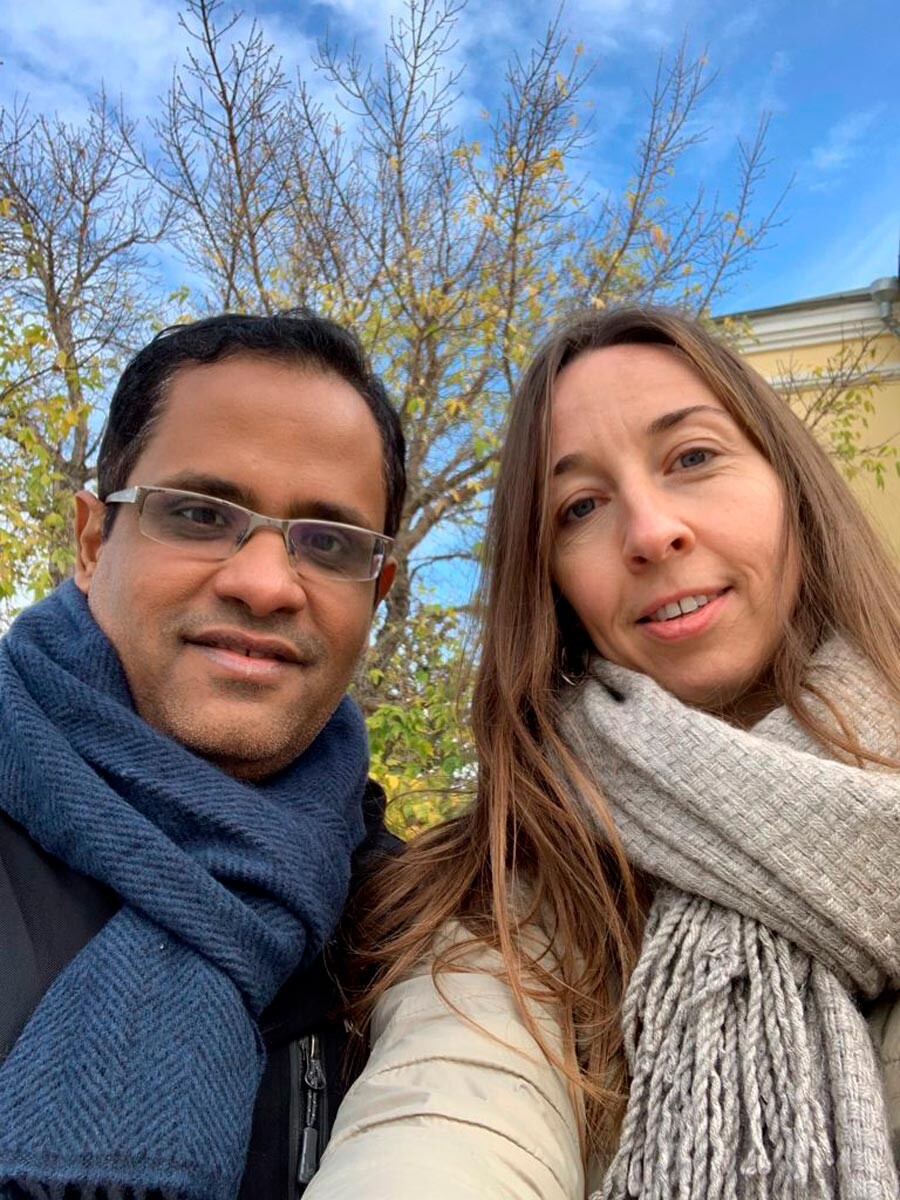
Ajay and his friend Olga on a cold morning
The small airport is just a 15-minute drive away from the city center and we were lucky to find an apartment in a well maintained Stalin-era building literally across the street from the Astrakhan kremlin.
Walk around the city at night
Our first task was to try out the much-hyped Caspian cuisine of the city. Although it was only 9:30 pm on a Friday, the beautifully landscaped area that is near Lenin Square and borders the Kremlin was almost empty. Tastefully lit, the area had a distinct Mediterranean feel. With a bearable cold breeze and crystal clear air, I found the surroundings to be romantic, but my travel partner said she had an eerie feeling, since we hadn’t seen any others in the street.
As we walked towards the riverside, we found our first Caspian-themed restaurant. Olga managed to calm down over a bottle of white wine and some local delicacies, such as sturgeon from the Volga Delta and ukha , which many restaurants label as the Tsar’s fish soup in their English menus.
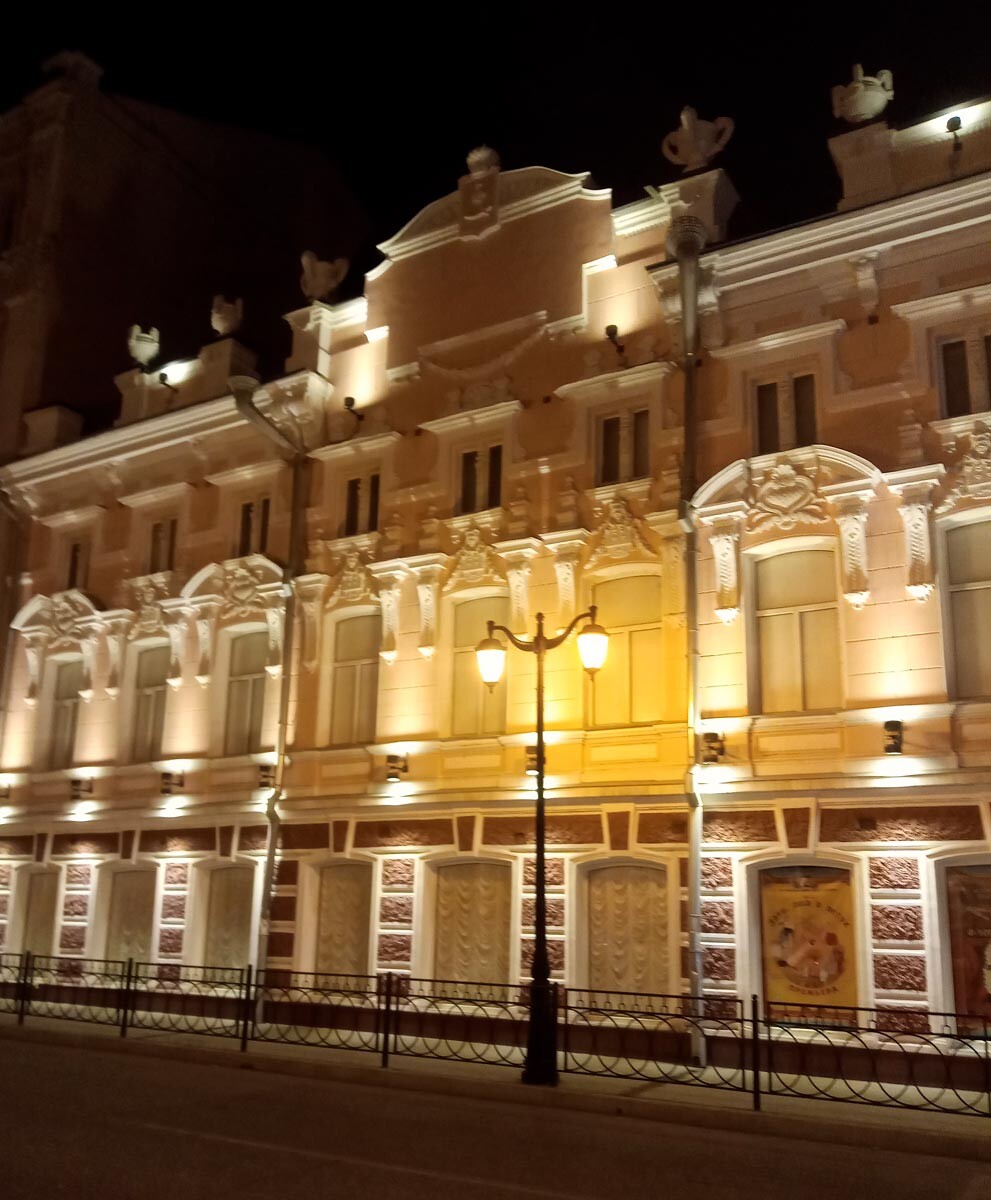
Astrakhan at night
The main activity at night in Astrakhan revolves around the streets leading to the Volga riverfront. This is where the youth of the city go clubbing or bar hopping. There were signs of nightlife in this stretch of the city, but we had seen far bigger crowds in much smaller Russian cities. Locals later told us that they took the pandemic more seriously than their counterparts in other parts of the country and, hence, there were so few people on the streets.
Feel the diversity on display at the Kremlin
On my first morning in the city, I set off on an exploratory run and was absolutely impressed with the city center. The square that was empty the previous night was a hub of exercise and sporting activity. Under clear blue skies and warm sun, I saw well-looked after flower beds and trees that had leaves of every fall color. The season of colors had come and gone from the northern parts of Russia in a hurry in 2021, but Astrakhan was still in mid-fall mode in November.
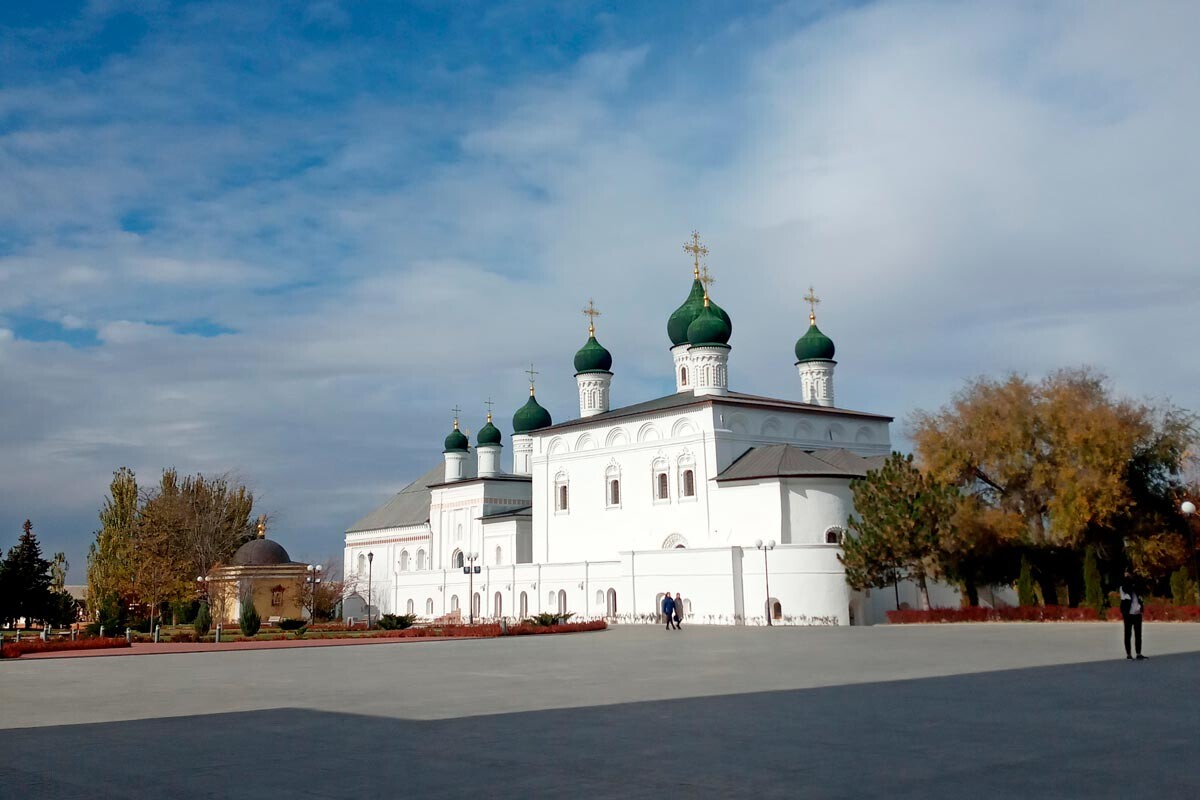
Church in the Astrakhan kremlin
Later that morning, we decided to explore the impressive white Kremlin that towers over the city center. Standing on the Zayachy Hill, this massive fortress was originally built in the late 16th century and has been modified a few times since. Entry to the Kremlin, which opens at 7 am, is free and there are stalls where you can buy local handicrafts. I couldn’t resist buying a handcrafted wooden fridge magnet with an engraved image of this ancient fortress.
The Kremlin is a great place to just roam around or sit on a bench and enjoy the great historical ambience, like many locals do, but we wanted to know more about this fascinating and well-preserved monument. So, we took a guided tour of the complex - in a golf cart! The modern-day Astrakhan Region was contested between various groups and empires until the middle of the 16th century, when it became a part of the southward-expanding Russian Empire. A knowledgeable guide shared many historical facts about the Kremlin and the city with us.
After our tour, we were in for an unexpected audio visual treat. As the sun fought the grey fall clouds and warmed up the temperature to 18°C and the bells tolled from the Assumption Cathedral, a group of teenagers in various ethnic costumes came to the area near the church. Over the next 20 minutes, the colorful group performed a series of dances that reflected the cultures of various ethnic groups who call Astrakhan home.
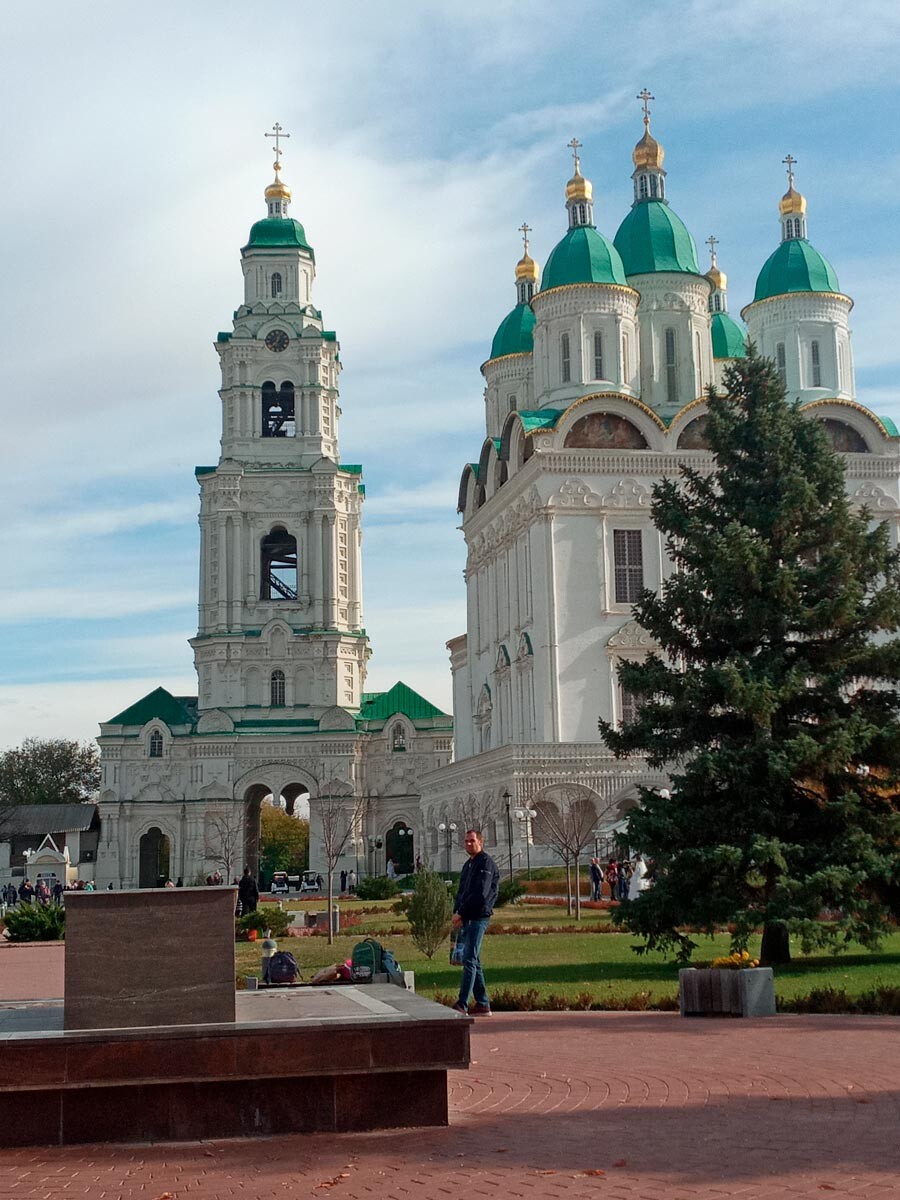
Astrakhan's Assumption Cathedral
We first saw a Russian folk dance, followed by a Tatar dance and then a performance of the indigenous peoples who inhabit Astrakhan Region. We were lucky to be in the Kremlin on the day the city was marking Russian National Unity Day .
This ethnic diversity can be seen everywhere in Astrakhan, but nowhere it is more visible than in restaurants and bars, where you see groups of people from different backgrounds socialising and making merry.
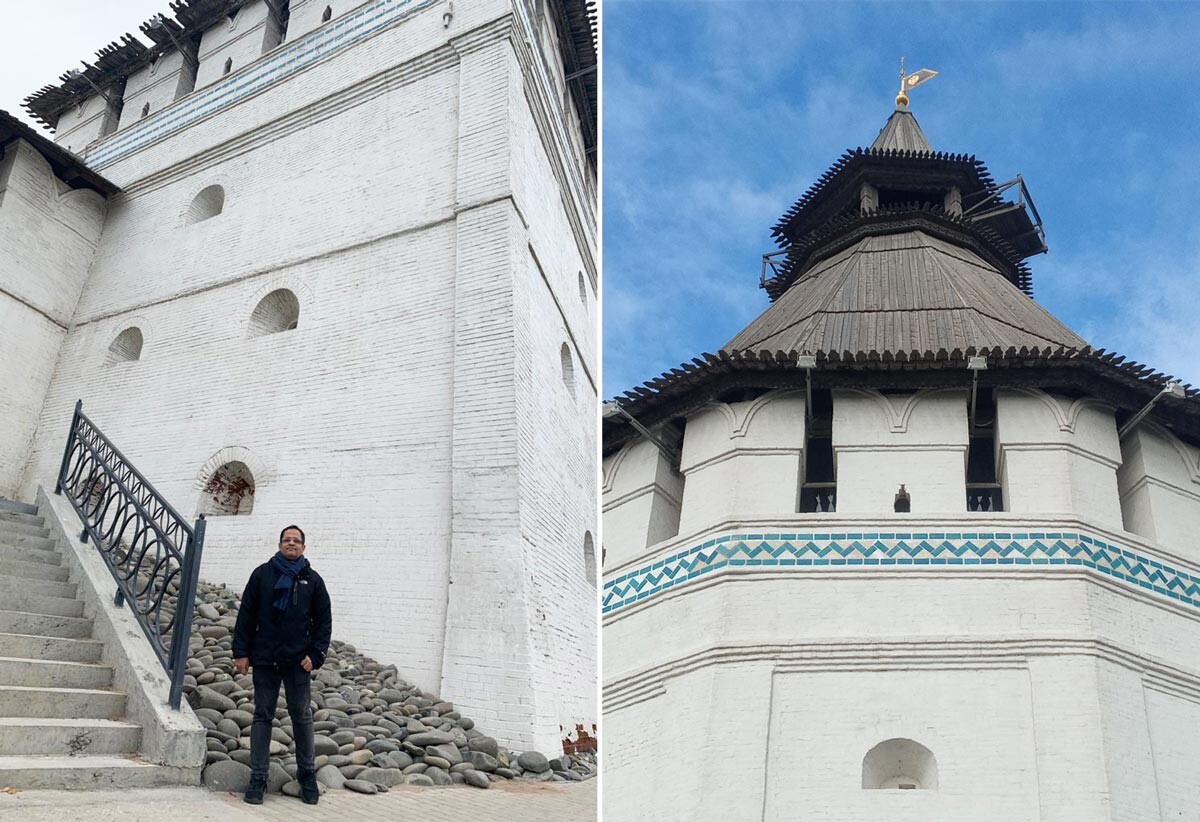
Ajay at the Astrakhan kremlin
Astrakhan is also known for its religious diversity. We went to two recently-renovated mosques that are just outside the historic city center. Non-Muslims are allowed to visit at non-prayer times. There seemed to be a strong Persian influence in the interior of these mosques, which is not surprising, given the fact that Iran is just across the Caspian Sea. The city also has an Iranian consulate and a Russian-Iranian banking joint venture. Some of the stores in the city sell imported Iranian candy.
During our three-day stay in the city, we had a chance to get acquainted with people from Dagestan, Turkmenistan and Kazakhstan. For those from other Caspian states, Astrakhan is seen as a logical entry point to Russia. In fact, several students from former Soviet countries study in the city.
Enjoy the unique architecture
The most interesting feature of Astrakhan is that no two streets in the historic center seem to resemble each other. A street full of early 1900s brownish-red brick structures is cut in half by a thoroughfare that has buildings that are a mix of Art Nouveau, Renaissance and Classicist architecture! Similarly, a walk by the outer walls of the 16th century Kremlin offers views of 19th century buildings that seem to have been transplanted from St. Petersburg.
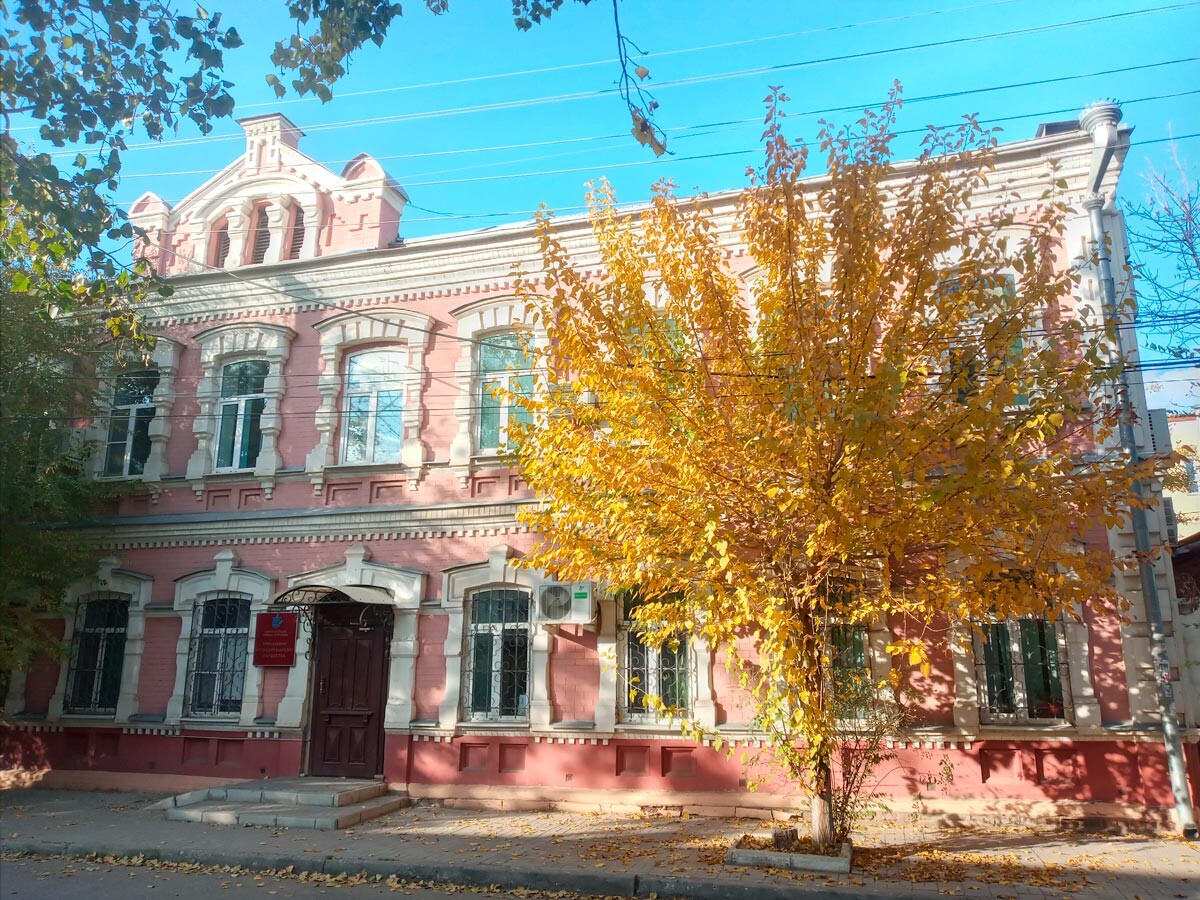
Tastefully restored building in Astrakhan
Long-term residents say many of the heritage structures in the city were in a state of disrepair, until a decade ago, when Russian President Vladimir Putin took a personal interest in reviving the city, given its strategic location close to the Caspian Sea.
The victory of the Soviet Union in the Battle of Stalingrad and the resulting halt of German troops advances into southern Russia helped save the older buildings of Astrakhan during World War II. The radius around the Kremlin and riverfront are European in character, but once you cross the canal, a totally different side of the city opens up. These areas have ethnic Persian and Tatar localities, locally known as ‘sloboda’. One gets a feeling of crossing over into an altogether different century when strolling past these areas with their wooden cottages and cosy courtyards.
While there is a strong sense of community here, the area is lower middle class and, unfortunately, did not seem to have any ethnic Tatar or Persian-style cafes. We were told that the best place to sample this kind of food was the Tatar Bazar, which we could not visit. Locals in these ethnic enclaves apparently preferred to either cook at home or eat at food courts in shopping malls.
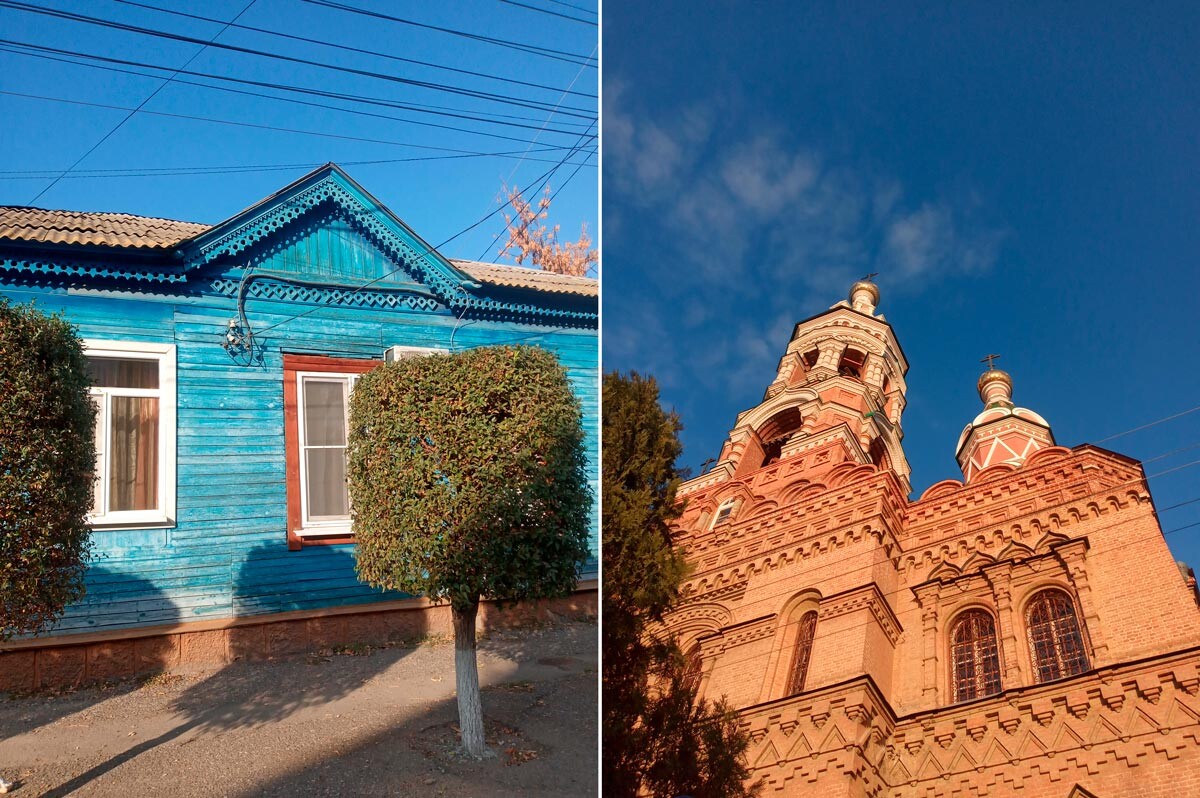
A wooden house outside the center (L); One of Astrakhan's older churches
The classical Russian neighbourhoods in Astrakhan have a wide array of dining options, including an elegant restaurant named ‘Onegin’ (named after Alexander Pushkin’s famous novel in verse ‘Eugene Onegin’), which has 19th century style interiors, chandeliers, paintings of the greats of Russian literature and plays the music of Russian composers Rachmaninoff and Tchaikovsky. Plenty of other restaurants are themed around the Caspian Sea.
Spend an evening by the Volga
It goes without saying that the best place to spend an evening in the city is the riverside promenade. Runners, bicyclists, families, university students and pensioners all converge on this stretch in the early evening, as another day heads off into the night.
The small islands that are visible from the promenade are home to a variety of birds that rush to find shelter in the trees before nightfall. As the river runs south towards the Caspian, nature is absolutely breathtaking. Visitors to Astrakhan in the warmer months often head to the Volga Delta, which is a biodiversity hotspot and home to various species of flora and fauna.
We made it a point to catch the sunset by the Volga twice during our brief visit. Few experiences in Russia compare with seeing the red sun set behind the country’s most iconic river. The ensuing twilight paints the skies of Astrakhan with a unique shade of crimson.
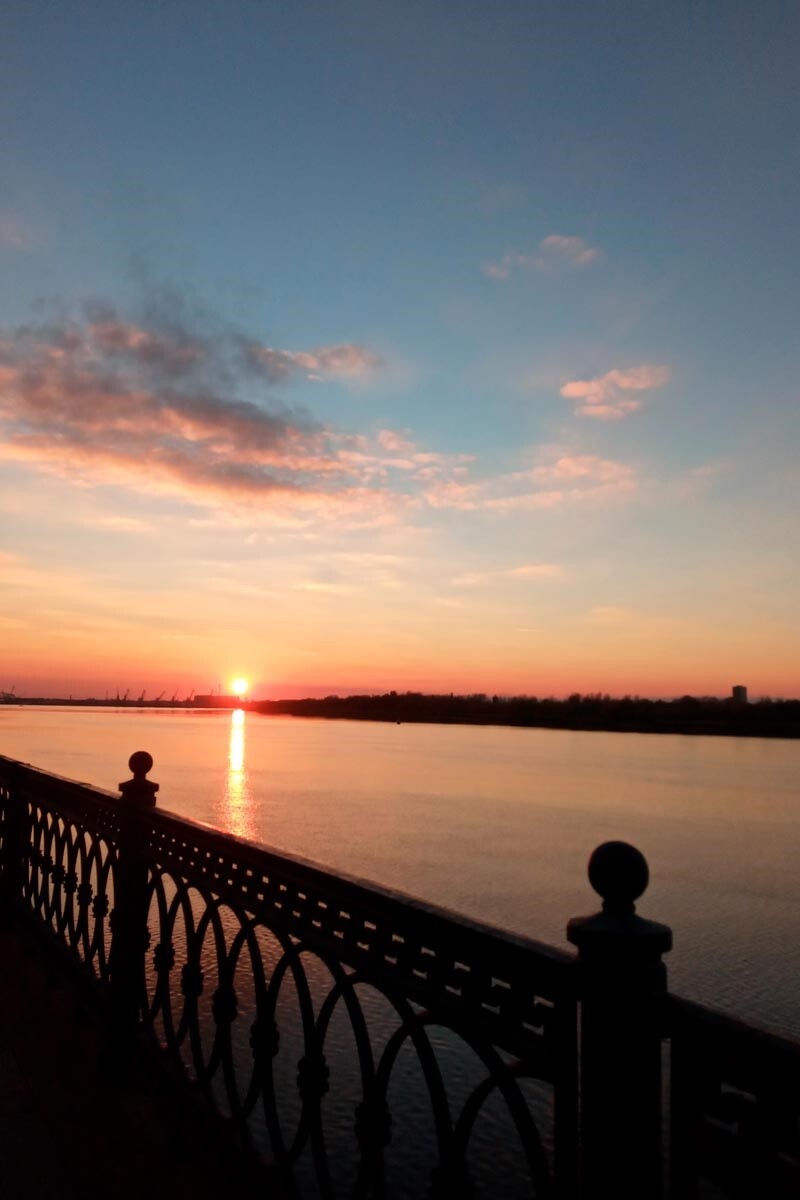
Astrakhan with Olga
Standing by the riverfront on my last evening in the city, my gaze went to the left, where some 100 kilometers south the great Volga empties into the Caspian Sea. This area has always been a major transit point connecting north and south, east and west. For several hundred years, it was the intersection of the east-west trade route north of the Caspian Sea and the north-south trade route down the Volga to Persia. I couldn’t help but think how the city had the potential to become a major business, logistics and tourism hub, if Russia, India, Iran and the Caspian littoral countries put a fresh impetus on developing the International North-South Corridor.
Astrakhan, as it is, is still a special place where several cultures meet and blend. As a melting pot of religions and ethnicities, no city in Russia (outside of Moscow) represents the sheer diversity of this colossally large country as well as Astrakhan. The city’s communal harmony and amity set an example for many other parts of the world that are struggling to deal with the close interaction of various ethnic groups.
If using any of Russia Beyond's content, partly or in full, always provide an active hyperlink to the original material.
to our newsletter!
Get the week's best stories straight to your inbox
- A one-day trip to Kashin, the town of ANCIENT churches and unexpected SPIRITS (PHOTOS)
- I spent a week in Sochi, the BEST place to go in Russia in the off-season (PHOTOS)
- What I did in the mountains of Krasnaya Polyana in the off-season
This website uses cookies. Click here to find out more.

- Visit Our Blog about Russia to know more about Russian sights, history
- Check out our Russian cities and regions guides
- Follow us on Twitter and Facebook to better understand Russia
- Info about getting Russian visa , the main airports , how to rent an apartment
- Our Expert answers your questions about Russia, some tips about sending flowers

Russian regions
- Adygeya republic
- Astrakhan oblast
- Kalmykia republic
- Krasnodar krai
- Rostov oblast
- Volgograd oblast
- Map of Russia
- All cities and regions
- Blog about Russia
- News from Russia
- How to get a visa
- Flights to Russia
- Russian hotels
- Renting apartments
- Russian currency
- FIFA World Cup 2018
- Submit an article
- Flowers to Russia
- Ask our Expert
Astrakhan Oblast, Russia
The capital city of Astrakhan oblast: Astrakhan .
Astrakhan Oblast - Overview
Astrakhan Oblast is a federal subject of Russia, part of the Southern Federal District, situated in the Caspian Lowlands where the Volga River flows into the Caspian Sea. Astrakhan is the capital city of the region.
The population of Astrakhan Oblast is about 989,400 (2022), the area - 49,024 sq. km.
Astrakhan oblast flag
Astrakhan oblast coat of arms.
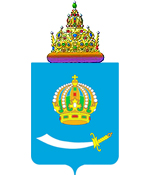
Astrakhan oblast map, Russia
Astrakhan oblast latest news and posts from our blog:.
4 March, 2020 / Astrakhan - one of the oldest cities in southern Russia .
18 May, 2019 / Colorful summer sunset in the Volga River delta .
4 April, 2019 / Cities of Russia at Night - the Views from Space .
11 May, 2017 / Astrakhan Kremlin after the Restoration .
13 December, 2016 / Astrakhan - the view from above .
More posts..
History of Astrakhan Oblast
In ancient times, the territory of the Astrakhan region was crossed by trade routes of the Persians and the Arabs. In the 8th-10th centuries, the territory belonged to the Khazar Khanate. There is a hypothesis that Itil, the capital of the Khazar Khanate, was located on this territory. It was destroyed by Prince Svyatoslav in 965.
Later, Polovtsy settled on this land. In the first half of the 13th century, the Mongol-Tatars came to the area. After them, Tatars of the Astrakhan Khanate and Kazakhs became the main population of the region.
In 1556, during the reign of Ivan the Terrible, the Astrakhan Khanate was annexed to the Russian state and ceased to exist. Astrakhan krai became the southeastern military outpost of Russia. In particular, in 1569, the Turks unsuccessfully besieged the fortress of Astrakhan.
In the 17th century, trade, fishing and salt industries developed in the region. In the middle of the 17th century, the uprising of Stepan Razin took place on the territory of Astrakhan region. In 1722, near the mouth of the Kutum River, a shipyard called the Astrakhan Admiralty was built. In the 1730s-1740s, the processing of silk and cotton began here.
Astrakhan Oblast was created in 1943. The region gained its current borders in 1957.
Steppe landscapes of Astrakhan Oblast
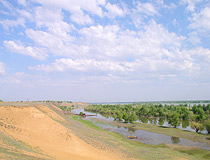
Astrakhan Oblast scenery
Author: Dvornikov Mikhail
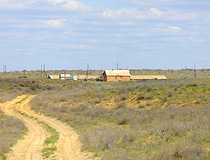
Steppe road in the Astrakhan region
Astrakhan Oblast - Features
Astrakhan Oblast is located in the south-east of the East European Plain within the Caspian Lowlands. It is an area of deserts and semi-deserts. Astrakhan oblast borders on the Volgograd region in the north, the Republic of Kalmykia in the west and Kazakhstan in the east.
It is located on the border between Europe and Asia, the Volga River gives access to five seas. The main cities of the region are Astrakhan (518,700), Akhtubinsk (35,500), Znamensk (25,700), Harabali (17,100).
The climate of Astrakhan Oblast is continental, dry. Winters are with little snow, frequent thaws and unstable snow cover; summers are hot. January is the coldest month, the average temperature is minus 10-20 degrees Celsius. July is the hottest month - the average temperature is plus 35-45 degrees Celsius.
According to the 2010 census, the ethnic composition of the local population is the following: Russians (67.6%), Kazakhs (16.3%) and Tatars (6.6%). Orthodox Christianity is the main religion. However, Muslims also make up a significant group of the population (more than 20%). Historically, this province was a place where Kazakhs and Tatars settled. The largest Kazakh community in Russia lives in the Astrakhan region.
Astrakhan Oblast views
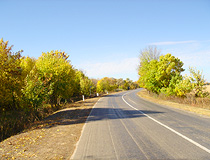
Paved road in Astrakhan Oblast
Author: V.Kildushov
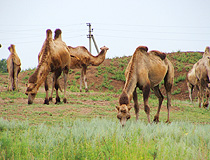
Camels in Astrakhan Oblast
Author: Viktor Grigoriev
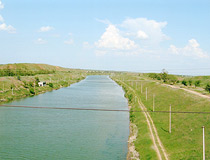
The Volga-Don Shipping Canal in Astrakhan Oblast
Author: Kudanov Pavel
Astrakhan Oblast - Economy
Natural resources of the region include natural gas, oil, salt, gypsum.
The industrial complex of Astrakhan, the economic center of the region, includes shipbuilding, pulp and paper industry, fish processing industry. The leading industries are fuel industry, mechanical engineering, power engineering, food industry. Astrakhan gas condensate field, the largest in the European part of Russia, is located in the area. Astrakhan Gas Processing Plant produces gas for cars, diesel and boiler fuel.
Agricultural lands make up more than 3.4 million hectares - the cultivation of tomatoes, peppers, aubergines, courgettes, cucumbers, carrots, beets, onions, cabbage, watermelons. Rice is traditionally grown along the Volga. The leading branch of livestock is sheep breeding.
The region stretches for over 400 km in the form of a narrow stripe on both sides of the Volga-Akhtubinsk flood-lands. Flooded for a long time, the territory of the delta serves as spawning-ground for such fish as sturgeon, stellate sturgeon, white sturgeon and others.
Astrakhan oblast of Russia photos
Pictures of astrakhan oblast.
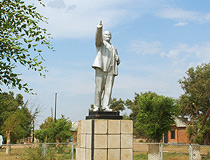
Lenin Monument in Astrakhan Oblast
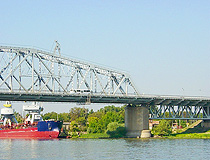
Bridge in Astrakhan Oblast
Author: Anatoliy Martyshkin
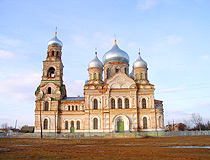
Church in Astrakhan Oblast
Limanskiy Khurul - the only active Buddhist temple in Astrakhan Oblast
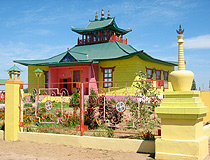
Limanskiy Khurul in Astrakhan Oblast
Author: Moskaluk Vitaly
The comments of our visitors
- Currently 2.95/5
Rating: 3.0 /5 (199 votes cast)

IMAGES
COMMENTS
FIELD TRIP definition: 1. a visit made by students to study something away from their school or college: 2. a visit made…. Learn more.
A field trip or excursion is a journey taken by a group of people to a place away from their usual environment. In education, field trips are defined as visits to an outside area of the normal classroom and made by a teacher and students for purposes of firsthand observation. A field trip can be expressed in many terminologies.
Field trip. A field trip or excursion is a journey by a group of associated peers, such as coworkers or school students, to a place away from their normal environment for the purpose of education or leisure, either within their country or abroad. When arranged by a school administration for students, it is also known as school trip in the ...
field trip: [noun] a visit (as to a factory, farm, or museum) made (as by students and a teacher) for purposes of firsthand observation.
Field trips can take place at local attractions, museums, historic sites, nature centers, and more. They can also be conducted virtually, allowing students to explore faraway places without ever leaving the classroom. Overview of Field Trips: Exploring the Benefits and Challenges. Field trips are an important part of any school curriculum.
FIELD TRIP meaning: 1. a visit made by students to study something away from their school or college: 2. a visit made…. Learn more.
Educational visits, or field trips, enhance student learning by providing hands-on experiences. Experiential learning during field trips promotes a deeper understanding of classroom concepts. Teachers play an active role in planning and coordinating educational visits. Educational visits enrich the curriculum and offer students diverse learning ...
Benefits of Field Trips. 1. Experiential Learning: Students can engage with real-world environments and phenomena, enhancing their understanding and retention of knowledge. 2. Hands-on Exploration ...
The school field trip has a long history in American public education. For decades, students have piled into yellow buses to visit a variety of cultural institutions, including art, natural history, and science museums, as well as theaters, zoos, and historical sites. Schools gladly endured the expense and disruption of providing field trips ...
Field trip definition: a trip by students to gain firsthand knowledge away from the classroom, as to a museum, factory, geological area, or environment of certain plants and animals.. See examples of FIELD TRIP used in a sentence.
field trip: 1 n a group excursion (to a museum or the woods or some historic place) for firsthand examination Type of: excursion , expedition , jaunt , junket , outing , pleasure trip , sashay a journey taken for pleasure
A field trip, by definition, is a school-sanctioned excursion away from the classroom and other traditional study environments ... Reeves, R., & Rodrigue, E. (2016, June 8). Fewer field trips mean some students miss more than a day at the museum. Social Mobility Memos. Student & Youth Travel Association (2016). A comprehensive survey of the ...
A field trip is a visit to an area outside of the normal classroom where children can try new things, have different experiences, and learn valuable life lessons. A field trip can be to countless ...
Field trips are an important part of education, offering students hands-on experience, introducing new perspectives, and improving student engagement. Field trips can also help students gain a better understanding of the topics they are studying, develop problem-solving and critical thinking skills, and cultivate curiosity and exploration.
Students will be out of the school building for a field trip, which means they will miss other classes—at least in middle and high school. If each core subject area (ELA, math science, or social studies) offers one field trip during a school year, students would be out of the building for four days. School attendance policies may count these ...
Typical school field trips include: The local museum for sciences or arts; A visiting play or musical performance; A local university or research center, with an expert or professional; While children always enjoy getting out of the classroom and experiencing something new, it can be difficult to truly engage with the entire group at all times ...
Definition of field trip noun in Oxford Advanced Learner's Dictionary. Meaning, pronunciation, picture, example sentences, grammar, usage notes, synonyms and more.
School field trip synonyms, School field trip pronunciation, School field trip translation, English dictionary definition of School field trip. n. A group excursion for the purpose of firsthand observation, as to a museum, the woods, or a historic place.
a trip made by a group of people, often students, to learn about something We went on a geology field trip. Delegates to the conference were taken on field trips to see the devastation. Definitions on the go
An ethnically diverse region that abuts the Caspian Sea in southwestern Russia, Astrakhan Oblast is home to the country's largest Kazakh community. Almost 150,000 people, or 18 percent of the oblast's population, identify as ethnic Kazakhs. Although Astrakhan does border Kazakhstan, most of them are not recent immigrants from the ...
Nordic, Southern European, Caucasian, Central Asian, West Asian and "typical Russian" features were all visible on the two-hour flight to the city by the Volga. As we were to find out over the ...
Astrakhan (Russian: Астрахань, IPA: [ˈastrəxənʲ] ⓘ) is the largest city and administrative centre of Astrakhan Oblast in southern Russia.The city lies on two banks of the Volga, in the upper part of the Volga Delta, on eleven islands of the Caspian Depression, 60 miles (100 km) from the Caspian Sea, with a population of 475,629 residents at the 2021 Census. [15]
Astrakhan gas condensate field, the largest in the European part of Russia, is located in the area. Astrakhan Gas Processing Plant produces gas for cars, diesel and boiler fuel. Agricultural lands make up more than 3.4 million hectares - the cultivation of tomatoes, peppers, aubergines, courgettes, cucumbers, carrots, beets, onions, cabbage ...